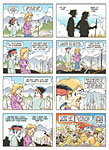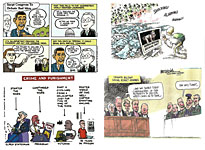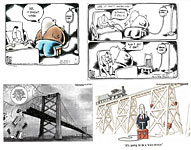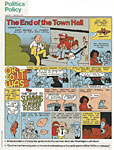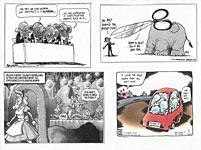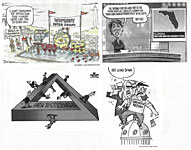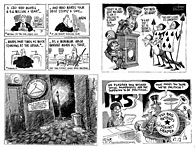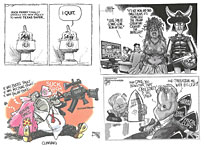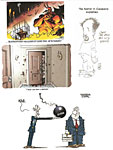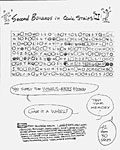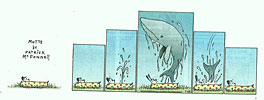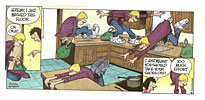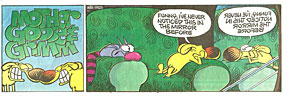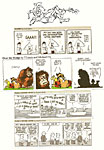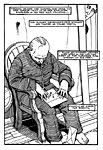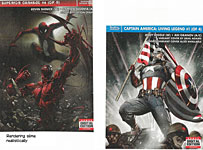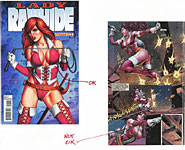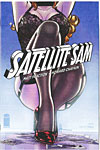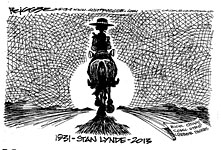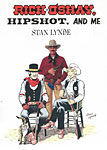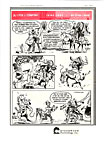 |
||||
Opus 315 (September 9, 2013). Hare-raising scandals—the Rumble in Riverdale, Batwoman Creators Quit, Spidey Stumbles on Broadway (and a dish memoir arrives)—plus some of the best editoons on the crises of August, reviews of Market Place, Elwell Enigma, The Education of Hopey Glass, Society Is Nix (Sunday Press’s newest gigantic-paged visit to the defining comics of 1890s through 1915), Gail Simone’s Red Sonja, Sergio Aragones’ Funnies, Lady Rawhide, Thumbprint, Lazarus; and reports on Egyptian cartoonists, Doonesbury’s return on Sunday, obit for Stan Lynde, and Mort Walker’s 90th. Here’s what’s here, in order, by department—:
NOUS R US Original Frank Miller Art Sold Betty and Veronica in Vanity Fair Mort Walker’s 90th Will Eisner at the Cartoon Art Museum Chris Ware Wary of Academic Accolades for Comic Art Stan Sakai Honored at Usagi Yojimbo’s 30th John Lewis’ Graphic Novel a Best Seller Salt Lake Comic-Con’s 30,000-plus Egypt’s Cartoonists at the Front Muslim Rabble Rouser Admits Mistake with Danish Dozen Doonesbury’s Return Delayed
THE ON-GOING RAPTURE OF EDITOONISTS Joe Heller, Phil Hands, Jeff Darcy —and Matt Bors Gets a Job
RUMBLE IN RIVERDALE PROLONGED Batwoman Creators Call It Quits over PC Tendencies at DC Spidey Stumbles and the Dish Begins Gahan Wilson Kickstarter Axe Cop Invented by Five-Year-Old
ADVENTURES AT THE DARKEST POST Editoons at the Denver Pest Disappearing? A Letter About Stone Soup
EDITOONERY Some of the Best of the Month on—: Syrian Crisis, Obamacare, and Other Issues Castro Monster Dead
JIVEY WORD GAME Name Second Bananas
THE FROTH ESTATE Jeff Bezos Buys the Post and the Journalistic World Goes Gaga But Isn’t This a Good Sign?
NEWSPAPER COMICS PAGE VIGIL Mutts, Zits, Breaking Taboos, Balloon Tails, —and the Secret Identity of Oompa Loompas
GOSSIP & GARRULITIES Conversations with Jeff Parker
BOOK MARQUEE: Short Reviews of—: Market Day Elwell Enigma The Education of Hopey Glass
BOOK REVIEWS: Long Critiques Society Is Nix: Gleeful Anarchy at the Dawn of American Comic Strips
LONG FORM PAGINATED COMIC STRIPS Graphic Novels Awash with Amateur Art Team Cul de Sac Noted
FUNNYBOOK FAN FARE Gail Simone’s Red Sonja No.1 Sergio Aragones’ Funnies, Nos. 1-8 The Return of Lady Rawhide More Chaykin Pin-ups on Satellite Sam Covers Thumbprint Lazarus
PASSIN’ THROUGH Stan Lynde
UNDER THE SPREADING PUNDITRY Comments on—: Do Nothing Congress Recesses Separation of Church and State Endangered by Religious Zealots Voting Rights Act Prison Population Military-Industrial Complex Is Militarizing the Border for Profit Fewer Messy Wars, Believe It Or Not
Our Motto: It takes all kinds. Live and let live. Wear glasses if you need ’em. But it’s hard to live by this axiom in the Age of Tea Baggers, so we’ve added another motto:.
Seven days without comics makes one weak. (You can’t have too many mottos.)
And our customary reminder: don’t forget to activate the “Bathroom Button” by clicking on the “print friendly version” so you can print off a copy of just this installment for reading later, at your leisure while enthroned. Without further adieu, then, here we go—:
NOUS R US Some of All the News That Gives Us Fits, in Paragraphs
The original art for the cover of Frank Miller’s Dark Knight Returns No.2 sold at Heritage Auction for $478,000. I assume Miller got most of the money after Heritage took its share. At the same auction in early August, Heritage also sold a near-mint copy of Batman No.1 for $567, 625. ■ In its September issue, Vanity Fair reports on the results of a survey conducted by CBS News of a random sample of 1,017 Americans to determine the Perfect Woman by considering various ingredients. Among the responses, 55% said they found women “bold and experienced” more desirable overall than women who were “sweet and innocent”—the latter is illustrated by a picture of Archie’s Betty; the former, by Veronica. ■ Beetle Bailey’s Mort Walker celebrated the 90th anniversary of his birth on September 3, just one day before the strip’s 63rd anniversary, and accolades from military top brass poured in. What else could they do? The Air Force had Steve Canyon, the Navy had Buz Sawyer, and the Army had—a private whose laziness was epic. Scarcely a representative worthy of the service. But Steve Canyon is gone; ditto Buz Sawyer. Beetle endures, a cartoonist’s monumental achievement. Among the military brass sending greetings was General Martin Dempsey, chairman of the Joint Chiefs of Staff, who wrote: “Your contributions to the nation and our military men and women through your comic strip Beetle Bailey are deeply appreciated. For more than 60 years you have given each of us something to smile about and a way to escape the everyday stresses of life.” When Beetle was 60, Walker told the Associated Press that he would continue cranking out Beetles until he was no longer able to. He still pencils the strip for his son Greg’s inks, and he presides over the weekly gag-writing sessions that involve Jerry Dumas (Silo and Sam) as well as sons Greg and Brian and probably Neal. Beetle Bailey runs in 1,800 newspapers in 52 countries with an estimated 200 millions readers. Happy birthday, Mort. ■ Denizens of San Diego are trying to reincarnate the old San Diego Comic-Con before it was invaded by Hollywood—“the friendly, intimate comic-convention experience of yore,” they say. It’ll take place for the second year at Town and Country Resort and Convention Center in Mission Valley, October 4-6. Special guests from comics and sf, no actors and actresses. Just cartoonists and writers. More at sdcomicfest.org. ■ The Cartoon Art Museum in San Francisco is featuring “Will Eisner, Father of the Graphic Novel” until November 10. (Eisner did not invent the graphic novel, but he explored its possibilities earlier and more devotedly than anyone else.) The show, curated by Denis Kitchen, a long-time student of Eisner’s works, displays original art from seven Eisner novels: A Contract with God, to the Heart of the Storm, Dropsie Avenue, City People Notebook, Life on Another Planet, A Family Matter, and Minor Miracles. ■ Chris Ware, speaking at a Stripped event during the Edinburgh Book Festival August 21 (or thereabouts), voiced his worry that as comics move further into the realms of literary accolades and academic study, their essential character as “a working class art form” and “art of the people” will be undermined. I’ve often had the same thoughts myself. ■ Stan Sakai was honored at this year’s Baltimore Con, September 7-8, with the publication of an art book in which 30 artists have drawn Sakai’s Uksagi Yojimbo on the occasion of the character’s 30 years of publication. Said Sakai: “I really enjoy seeing other artists’ interpretations of Usagi. They range fro pure humor to very dramatic to high action—just like my own stories.” Sakai drew the book’s cover. While Con organizers hope to sell all the books during the Con, they’ll explore ways to sell any left-overs; check the website, baltimorecomiccon.com. ■ Congressman John Lewis (D-Georgia) added "best-selling author" to the list of honors he's accumulated as a civil rights leader. The graphic novel, March: Book One, which he helped write about his life as a Freedom Rider and his quest for social justice, is No.1 on the New York Times' best-seller list for paperback graphic books. ■ Stan Lee accepted at the last minute an invitation to appear at the Salt Lake Comic-Con, September 5-7. At this writing, no word yet about whether he reneged, as he did for the Denver Comic-Con. Salt Lake planners said 30,000 tickets were sold in advance, and they anticipate a final count in excess of 40,000. For comparison, the first New York City Comic-Con a couple years ago registered just over 30,000.
CARTOONISTS AT THE FRONT IN EGYPT In Egypt,
cartoonists participate in the on-going protests by hanging their cartoons in a
tent gallery in downtown Cairo. When, on August 14, authorities cleared the
demonstration (and killed 235 people in the process), the cartoon gallery, like
the rest of the demonstration, turned to mud and blood. But that night,
cartoonists were again drawing cartoons to post on Thursday, according to
Jonathan Guyer at the newyorker.com. Starting at the left is a poster made in January 2012 by Ganzeer and revived again and again over the ensuing months. Entitled “The Army Above All,” the poster made the rounds of Facebook and Twitter on that tragic Wednesday. The sign crumpled up at the bottom of the pile of skulls reads: “Bread, Freedom and Social Justice,” the chant of the January 2011 uprising. Ganzeer, Guyer writes, “is one of Egypt’s preeminent graphic artists: his stencils and decals can be spotted on walls throughout Cairo.” The artist wrote Guyer from Helsinki: “Regardless of whoever’s doing the killing and whoever’s being killed, a massacre is still a massacre.” Next going clockwise is a cartoon by Andeel, captioned: “Last Night I Tried to Cry about All the People Getting Killed ... Nothing Came Out.” Says Guyer: “Wednesday’s violence was something that the country sort of expected. Egyptian authorities attempted to clear Rabaa on July 7th and 27th, killing 52 and 72 people respectively. In that environment, Andeel, a cartoonist for the independent Al-Masry Al-Youm newspaper, poses a challenging question to the reader: at what point will Egyptians become desensitized to violence?” Finally, at the bottom, right, is a cartoon originally published in a newspaper but revived on Facebook by cartoonist Tarek Gafawy, who said: “All blood is equal. I care about humans.”
A LITTLE MISTAKE ABOUT THE DANISH DOZEN This from the Guardian: Ahmad Akkari, a Danish Muslim leader who traveled through the Middle East inciting outrage at the Prophet Mohammad caricatures published in the Danish newspaper, Jyllands-Posten, in 2005-06 now says that was “wrong.” “I want to be clear today about the trip: it was totally wrong,” Akkari said. A little late: an estimated 200 people died in the riots he helped foment. Akkari continued: “At that time, I was so fascinated with this logical force in the Islamic mindset that I could not see the greater picture. I was convinced it was a fight for my faith, Islam.” He said he’s still a practicing Muslim but started doubting his fundamentalist beliefs after a 2007 trip to Lebanon, where he met Islamist leaders. “I was shocked,” he said. “I realized what an oppressive mentality they have.”
DOONESBURY’S RETURN DELAYED Garry Trudeau announced last May that he was taking the summer off to concentrate on writing and producing the first season of his Amazon Studios tv show, “Alpha House.” Now, citing the demands of the project, Trudeau says the daily Doonesbury hiatus has been extended until November. In a letter to newspaper editors Garry writes: “I
have hit the wall. This is a painful decision, but as the deadline loomed, I
had to finally concede that the demands of completing the show have made it
impossible for me to return to the strip on schedule. I deeply regret the
inconvenience this will undoubtedly cause you, who have already shown much
forbearance and patience through Doonesbury’s The Sunday version returned hilariously on September 8 with Zonker and his nephew Zip contemplating the complete destruction of their first “grow” of grass in the pot state ofColorado—destroyed by one of the numerous forest fires that have plagued the state for the last two years. Here’s how Trudeau plays it, a purely Trudeauian Return, with bells on.
In 1962, Hauser Press published Today’s Cartoonists (written in conjunction with the Association of American Editorial Cartoonists), in which editoonist John Chase produces two-page biographies with sample cartoons of 140 of the nation’s editorial cartoonists. There may have been more at that time, out of the purview of AAEC and Chase; but there were at least 140.
THE ON-GOING RAPTURE OF EDITOONISTS Heller Laid Off, Hands Hired, Darcy Stays, Bors Triumphs The ranks of full-time staff editorial cartoonists fluctuated up and down last month, with a net gain, hoorah. After 28 years at the Green Bay Press-Gazette, editorial cartoonist Joe Heller was told he was part of a Gannett-wide layoff, Alan Gardner reported at DailyCartoonist.com. In the same state, though, editoonist Phil Hands was added to the staff of the Wisconsin State Journal after eight years as a freelancer. Meanwhile, Jeff Darcy at the Cleveland Plain Dealer, whose position seemed threatened a few weeks ago, survives. And altie Matt Bors, 2012 winner of the Herblock Prize, found a full-time, paying editorial cartooning gig, bringing the tally of full-time staff editoonists to 51. The first increase the muster has seen since 2008. ■ Heller had a feeling he might be headed for the chopping block, he told Gardner: “I was given no notice of my layoff, although my spidey-sense was tingling for the past month or so. Rumors and too many closed-door meetings, etc.” He’ll rebound more quickly than many of his peers who’ve had the same experience. Said he: “I’ve dodged the axe so many times, that when it did happen, I was prepared.” Heller has been self-syndicating his cartoons for years and now has a client list of more than 350 newspapers. He’ll continue to draw his editorial cartoons at his home studio and looks forward to expanding his list: “Without the restrictions that my former paper put on me—and there a too many to note—I can now expand my empire to online and circulation areas that were off limits.” Ironically, the week after he was laid off, he added to his list a newspaper group representing 26 newspapers. (Oh—and Heller kept all 7,450 of his original cartoons done for the Press-Gazette.) ■ At the State Journal, Hands will continue to do three cartoons a week and a caption contest, and as a staffer, he’ll also manage the features pages with the comics, puzzles and advice columns, and he’ll do occasional illustrations. ■ In Cleveland, Darcy told Gardner that his job is secure, rumors to the contrary notwithstanding, and that his cartoons will actually be printed larger henceforth. “My work will not only continue to appear in print,” Darcy said, “but will be part of an expanded Forum section in which the cartoons will run double the size they are now, and in full color.” His work also appears on Cleveland.com where Darcy has been posting written commentary under the cartoon.
■ MATT BORS, who has been plying the alternative newspaper waters freelance, has landed a full-time, paying staff job at a new website, Medium, a year-old start-up created by Ev Williams, the founder of Blogger and, later, Twitter. After leaving both of his previous inventions, Williams has become increasingly disenchanted with commercial news outlets, which seem too prone to do anything to attract eyeballs. Said Williams (in Bloomberg Businessweek, August 26 - September 1): “[News sites] create a culture that is superficial and fetishizing and rewarding the wrong things and reinforcing values that are self-destructive and unsustainable.” He hopes Medium will contribute to improving matters by providing a platform for well-reasoned articles that can generate meaningful compensation for their authors (not many of the latter, so far). “We don’t pretend that we can make people eat their vegetables when there’s potato chips on the table,” Williams said, “but we want to provide an alternative for those who want some diversity in their diet.” Until the site generates real revenue, presumably Williams, easily a millionaire, is footing the salary bill. Says Bors: ““I’m air dropping into this little experiment in writing and publishing to lob some cartoon bombs—the big ‘ol round ones with long wicks we like to draw. Here’s my first piece, Unpaid Internships Must Be Destroyed. Not to give too much away, but I don’t really care for them. I also posted some recent comics on bombing Syria (which appears in the appropriate segment of our Editoonery department below), white birthrates in America, and a modest proposal for profiling in our inner cities.” Bors will also be editing for Medium an online collection, “The Nib,” featuring “political cartoons, comics journalism, and other non-fiction comics from some of the best in the field. Comic journalists like Susie Cagle and Wendy MacNaughton; political cartoonists Ted Rall, Jen Sorensen, and Brian McFadden of the New York Times. “Expect new editorial cartoons from me every week,” Bors continues at his website, “as well as longer opinion comics, illustrated journalism, doodled takedowns, infographics, and, well, whatever I want, really. I’m being given incredible freedom here to do what I do. I love the freedom so much I’ll probably even go crazy and do some writing once in a while. That’s still a good medium for doing a few things, I guess.” With a little Kickstarting, Bors has just published a collection of his confrontational cartoons augmented by a flotilla of acerbic essays on related topics (and, as you can tell if you read his cartoon/essay on unpaid internships, Bors can be acerbic to the nth degree, and he doesn’t seem to like much of anything in the socio-political world around him), Life Begins at Incorporation, 238 8x9-inch pages in paperback, available for twenty bucks at his website, www.mattbors.com. In the book, Bors writes about Obama in an essay entitled “More Like Obummer”: “Obama is a kind of Rorschach blot president. One person sees a Good and Decent Family Man, another sees a Socialist Usurper with a Broccoli-Nazi for a wife. I see a guy who is probably the best our current system can produce—which doesn’t bode well for the system. Obama became president during at a time when fundamental change was required. He needed to make the case for government’s helpful role in society the way Ronald Reagan made his presidency an argument against it. There may not be a right-wing president to take issue with for quite a while. The Dems are it. The GOP has positioned itself to be a permanent minority party. Most of the destructive economic policies and Bush-era war powers remain intact, and Obama hasn’t surprised us with any bold progressive era yet. I know: you can only do so much. But you have to do enough.” I’m not sure I agree with all that, but I agree with enough of it. Bors seems as unblinkered a commentator on the current political and social scene as we have. Don’t miss his book.
THE RUMBLE IN RIVERDALE PROLONGED Behind the scenes at Archie Comics, legal machinations continue to clank loudly. Choosing between Betty and Veronica, it turns out, is the least of Archie’s worries. The rumble in Riverdale (as Dareh Gregorian at the New York Daily News calls it) began in 2011 when Nancy Silberkleit, who inherited her co-CEO position at the death of her husband Michael, was accused of sexually harassing male employees, once barging into a meeting and yelling “Penis! Penis! Penis!” and pointing to the men present. I’ve always thought she was being satirical, but the Archie hierarchy took her seriously: she was enjoined from entering the offices. Needing a go-between, 59-year-old Silberkleit named a friend of 40 years, Sam Levitin, 73, as her liaison with the office. But her friendship soured late last year when, she alleges in a new law suit, she rejected Levitin’s “unwanted and improper sexual advances.” Levitin leered at her, asked her if she planned on getting breast implants, and threatened her, Silberkleit charged, recounting an incident where she said Levitin told her, "mess with me, lady, (and) you're playing with fire." Levitin denied calling her "lady," but said he did say she was "playing with fire" with her plans for Betty and Veronica, "characters that have been known and loved for generations."Levitin says Silberkleit had plotted to tart up Archie Andrews' longtime love interests, but, according to court papers, he warned her: "This is not Penthouse or Playboy." He says Silberkleit is “unstable” and if she remains in a position of power, "she will greatly damage the business." Silberkleit's lawyer, Paul Jaffe, said the allegations against his client "are just not true." In an affidavit, Levitin denied hitting on her, and said the real reason their relationship soured is because she treated him—and everyone else at Archie—like they were real Jugheads. "Nancy is incapable of working with anyone," he said. "She lacks functional communication skills and has an unstable temperament." He said he initially believed her claims that she was slimed in the earlier Archie suit, but once he started there, "I was able to see first hand the venomous and destructive effect Nancy was having at Archie.” At business sit-downs, he said, "she acts in a disruptive manner by using her cell phone, coming and going in the middle of meetings, and not staying long enough to understand the objectives and purpose of the meeting." Citing her bad behavior, Levitin filed court papers in December seeking to have her removed as an Archie trustee. Silberkleit followed suit by seeking to have him removed from his job, citing his "unwelcome advances." She then filed a sexual harassment claim against him and the company this past April, claiming she "has been and continues to be the subject of unwelcomed sexual harassment" at Archie's offices in Mamaroneck, Westchester County. Archie hired an outside firm to investigate her claims, and it determined her allegations were "unfounded." In a statement, Archie Comics said only that, "The company is not a party in the litigation." (Virtually all of the foregoing, beginning with the third paragraph, is taken verbatim from Gregorian’s account of August 2.)
BATWOMAN CREATORS LEAVING IN A HUFF From ICv2.com: Continuing a run of creative defections from DC after conflicts over editorial decisions, J.H. Williams III and W. Haden Blackman are leaving Batwoman after No.26. The move was announced by identical posts on the creators’ websites that detailed how the team planned storylines many issues in advance (five story arcs at the outset), and were following those plans but last-minute changes demanded by their editor left them "frustrated and angry." "Unfortunately, in recent months, DC has asked us to alter or completely discard many long-standing storylines in ways that we feel compromise the character and the series," they wrote. "We were told to ditch plans for Killer Croc’s origins; forced to drastically alter the original ending of our current arc, which would have defined Batwoman’s heroic future in bold new ways; and, most crushingly, prohibited from ever showing Kate and Maggie actually getting married. All of these editorial decisions came at the last minute, and always after a year or more of planning and plotting on our end." They called Batwoman "a dream project for both of us" and are clearly unhappy at leaving the book, but feel they must. "We can’t reliably do our best work if our plans are scrapped at the last minute, so we’re stepping aside," they wrote. ICv2 added: “Departures from DC, often over creative differences, have been a running story recently” but “DC’s co-publishers argue that the churn is normal, and that in fact, editorial control is looser than it’s been in the past.”
SPIDEY STUMBLES AND THE DISH BEGINS For the first time since performances began in rehearsals in November 2010, the Broadway musical “Spider-Man: Turn Off the Dark” took in less than $1 million for a standard eight-performance playing week, with last week’s gross totaling $966,952, reports Patrick Healy in the New York Times (August 26). “While ticket sales have been softening since last fall for the $75 million musical, the most expensive in Broadway history, a spokesman on Monday linked last week’s total to ‘fallout’ from a well-publicized foot injury suffered by the cast member Daniel Curry during the August 15 performance.” Healy continues: “The low gross is notable because, over the last two years, the ‘Spider-Man’ producers have explicitly pointed to their seven-figure grosses as a sign of audience validation for a musical that critics widely panned. The producers have also been optimistic about earning back the show’s $75 million capitalization, but that feat would require weekly box office grosses in the $1.5 million range for several years. Last week’s gross was below the show’s weekly running costs, which are in the low seven figures.” But, adds Healy, quoting a spokesman for the show, “‘Spider-Man’ remains one of the highest grossing shows on Broadway, and we expect this dip to be little more than a temporary reaction to the media coverage.” “Spider-Man” remains a fan favorite, Healy says: “No Broadway musical has endured so many bad reviews and so much negative publicity — over the firing of its original director, Julie Taymor, and over cast injuries in its early months — yet continued to run for nearly three years with mostly million-dollar weeks.” A week later, Healy reviewed a new book, Song of Spider-Man, “a dishy insider memoir” that “chronicles the ugly slide of the once close creators, the director Taymor and the composers Bono and the Edge of U2, into a morass of betrayals, lawsuits, and petty slaps, like a producer’s yanking Taymor’s tickets for the show’s opening night. The backstage bickering, cast injuries and Taymor’s ultimate firing are rendered in close-ups by an observer especially near the action: Glen Berger, who was chosen by Taymor to collaborate on the script for the musical.” Berger was later encouraged by the show’s producers to write a Plan X, “without Traymor’s knowledge,” that would “turn the show into a sunnier, family-friendly entertainment.” “Berger’s tortured pas de deux with Taymor dominates the book,” says Healy, quoting from the book’s first chapter: “Even now, I still carry the dream with me every day — to make up with her. I loved her. I still do. With heart-scarred bewilderment, I love her. And the thing of it is—she despises me.” Says Healy: “A spokesman for Taymor said on Thursday that she had not read the book and had no comment on it.” But Berger’s duplicity “eats away at him, and leads to a deep rupture when Taymor learns of Plan X and dismisses it as ‘a cut-and-paste mess.’ Most theater critics eviscerated the show’s script and its songs during a first round of reviews in February 2011 and again in June of that year [when it officially opened], after parts of Berger’s Plan X were incorporated and Taymor had been fired.” Healy goes on: “Berger said he did not reach out to Taymor about the book, largely because of a lawsuit she filed against him, the producers, Bono and the Edge, which has since been settled. But he said he recently received a phone message from her: ‘What followed over the next two days was a handful of e-mails and three hours of conversation,” Berger wrote in the e-mail. ‘The conversations weren’t just civil, they were genial —strange and psychedelic for being so almost normal.’”
GAHAN WILSON KICKSTARTER Filmmaker Steven-Charles Jaffe has made a documenary film, “Gahan Wilson: Born Dead, Still Weird,” and last month aimed to Kickstart it into theaters in order to qualify for an Oscar (which requires a one-week theatrical run). Jaffe has been a Wilson fan since the age of ten when he saw his first Wilson monster, and he was subsequently inspired to make a film by Terry Zwigoff’s “Crumb.” Wilson was reluctant to commit to doing a documentary, Jaffe told Michael Cavna at ComicRiffs.com, but on a long research trip together, he convinced the cartoonist to do some “casual interviews on film,” and Wilson subsequently agreed to Jaffe’s project. Gahan was actually, literally, “born dead,” Jaffe explained, “—and luckily revived by the family doctor. Apparently his mother was given too much of a narcotic—a sedative—with a lovely nickname, ‘Twilight Sleep.’ “Gahan grew up during the Depression,” Jaffe continued, “and as he put it to me, things were tough enough, but when your parents go routinely nuts every night, leaving bottles of alcohol all over the place, it’s pretty tough for an only child.” “Given that Gahan was raised in such a house of true alcoholic terrors,” Cavna observed, “it would be natural to see the monsters as symbols of his parents.” Jaffe has spend more than six years on the project and now wants to bring it to Oscar glory. He needs $50,000, and last time I looked (September 4, long past the deadline), he’d raised not quite half—and the Kickstarter period is now over. Presumably, we can still see the film somewhere albeit without an Oscar attached (but it won 2011 Best Documentary Award at the Comic-Con). And it oughta be a fun screening. “Born Dead” features interviews with some of the cartoonist’s celebrity fans, including Neil Gaiman, Lewis Black, Guillermo del Toro and Stephen Colbert. In making one last “shameless” plea, Jaffe quoted Robert Redford, who, after seeing the film, said: “I am a huge proponent of art not only getting into the educational system but also because it can save some lives as it enhances others.” Said Jaffe: “Such a beautiful and wise statement. Gahan survived alcoholic parents by drawing monsters before he could read or write, so in a sense, his art saved him. And he’s still at it” (at the age of 83).
GETTING THE AXE A webcomic created in 2009, Axe Cop is about a gruff and manly crime-fighting copy who prefers his fireman’s ax to a gun. Axe Cop is also a not-very-subtle comment on our culture and what we find entertaining: it was created by a 5-year-old kid, Malachkai Nicolle, and his cartoonist brother Ethan, who was then 29 years old. I’ve often thought that our cultural tastes were juvenile, but I hesitated—until now—to assume they were also infantile. But now we know. Axe Cop has graduated to television, specifically, Fox on Saturday night. Now we know about the intellectual capacity of Fox viewers. At readexpress.com, Rudi Greenberg viewed the series’ debut entry and didn’t like it. Greenberg supposes that “Axe Cop” is intended for adults, but it’s “far too juvenile,” he says. And when the second episode turns into “one long poop joke — Axe Cop fights a ‘poop monster’ named Dr. Doo-Doo in London, ‘where poop gets its power’— any hopes of this being smart, adult comedy gets flushed down the toilet.”
ADVENTURES AT THE DENVER PEST Bad news for cartooning in these parts. On Tuesday, August 6, the Denver Post introduced its latest money-saving contrivance. The page width was reduced by an inch, so the Post joins numerous other metropolitan daily papers in being narrower than before. I’d like to say the paper is sleeker in consequence, but that implies that an improvement took place. Not so. The downsizing of page width will conserve newsprint and save money. But the ominous development is on the editorial pages. With less surface to print on, management has taken draconian steps to reduce content to fit into the smaller available space. To wit: the Post dropped its op-ed page, leaving only one page for the editorials. To make room for the editors’ profundities and the absolutely indispensable letters to the editor, the editorial cartoon is being regularly left out. It was missing four out of the first six days of the new design. The paper usually publishes an editoon on Saturday and a couple on Sunday in an expanded “Perspectives” section. But Monday through Friday, we went without for the first week of the new regimen. This is changing: lately, we’ve been seeing a couple editoons on weekdays. Mildly encouraging, but not enough. The Post no longer has a staff editoonist, so no one’s out of work; but it does not portend well for editorial cartooning: the Post won’t be using as many syndicated editoonists as it once did. Elsewhere, management consolidated the comic strip and crossword puzzle section from three pages to two. They did this by shrinking the comic strips. Not squeezing them—distorting proportions—thank God; but shrinking drastically: from 5 3/8" wide to 4 7/8". The horizontal dimension, however, is not the dimension they sought to gain space with. They lopped 2/8 of an inch off the vertical dimension which permits them to stack more strips on the page. And this maneuver crams 2 ½ pages of strips onto merely 2 pages. Everything is therefore much smaller. I pointed out in a letter to the editor (that he declined to publish) that now the numbers in the squares of the New York Times crossword are larger than the letters in the words of the speech balloons—adding that since newspaper readership skews older, they were short-changing the majority of their readers, mostly old gaffers like me who can’t see small print. This is the same paper that dropped Doonesbury and Peanuts on the same day a couple years ago. If there are two comic strips that I would have said were invulnerable, those were the two. Why’d they drop them? Undoubtedly to reduce their costs: they now run a great number of comic strips from what I’d guess is the “second tier” of popularity; so the weekly fees for them are less. And Doonesbury and Peanuts, being national institutions with large circulation, surely cost more than a half dozen of the second tier line-up. A couple weeks ago they dropped For Better or For Worse. No great loss, I suppose: the strip’s been in reruns for several years. But when they added Jan Eliot’s Stone Soup to take FBOFW’s place, they didn’t bother to explain who the characters were or what the setting or theme was. Sink or swim. I’m familiar with the strip, so I know the strip focuses on the two families of sisters who live next door to one another and one’s married and the other isn’t anymore and they both have children running all around. But I look at it now and wonder how the average reader, new to this milieu, can make sense of it—all those nameless kids, and who are their parents? Altogether—shrinking the readability of comic strips, dropping famous ones, dropping the editorial cartoon—the Denver Post may be the bellwether for American newspapers. Makes me weep.
A LETTER ABOUT STONE SOUP. When Stone Soup began in the Denver Post without any sort of introduction—a journalistic crime, given the complexity of the strip’s milieu—I wrote the Post, offering the following paragraphs as a way of introducing the new strip: Our new comic strip, Stone Soup, by Jan Eliot, focuses on an extended, blended family, starring two working-mom sisters, Val and Joan Stone, living just across the fence from each other. Val, a 39-year-old widow, has two daughters, one 13 and the other 10; Joan, a divorcee at 36, who, in 2000, married Wally Weinstein (but kept her last name), has a 3-year-old son from her first marriage, a 6-month-old daughter with Wally, and a step-nephew, 16. The sisters’ mother, "Gramma" Evie Stone, lives with Val and keeps up an appropriately crusty critique of modern parenting methods. The strip takes its name from a folk tale about an impoverished wanderer, who, unable to persuade some villagers he encounters to feed him, fills a pot with water, puts a stone in the water, and brings the pot to a boil. He tells curious villagers that the stone soup could use a little garnish for flavor, and, one by one, they donate carrots, onions, and so on, until he has a fine soup, which he shares with everyone. In the same way, Eliot’s strip aims to make something flavorful by accumulating lots of small contributions from the members of the family. The family circle, at first (when a weekly strip starting in 1990; then as a syndicated daily starting in 1995) was headed by single mothers, unlike the nuclear families depicted in most family comic strips. Eliot explained: "When I write I am writing first and foremost for single and working parents. I often felt very isolated and ‘put down’ because of my circumstances (I was a single working mom for 10 years). I even had a teacher tell me that their school ‘was a better place before all the single moms arrived.’ My daughters both turned out fabulously, thank you, and I think I was a good parent." Eliot travels a good bit—as does Gramma Stone, who (with her new boyfriend) went to Uganda to build houses for an aid organization in 2006; and to Thailand to work with Habitat for Humanity in 2009. For the first three months of this year, Eliot took light table, scanner, ink, paper and pens (and her husband Ted) to Cape Town, South Africa. "It was summer in the Southern Hemisphere," she blogged a few weeks ago, recounting her adventures there in a rented house overlooking False Bay and the Cape of Good Hope, "—sunny nearly ever day, the sea was gorgeous and wild and beckoning—which inspired me to work twice as fast. ... South Africa is a gorgeous place, and False Bay is fed by both the Atlantic and Indian Oceans. It’s green like the Mediterranean but big and wild like the Pacific. Big pods of dolphins, whales, great white sharks, wild beaches where you might also see baboons, ostriches, antelope," and colony of penguins, which inspired a cautionary sign: "Warning: please look under your vehicle for penguins." Envoi. Naturally, they didn’t run my article. Stone Soup continues to bubble on, its readers largely ignorant of who those people in it are.
Fascinating Footnit. For even more comics news, consult these four other sites: Mark Evanier’s povonline.com, Alan Gardner’s DailyCartoonist.com, Tom Spurgeon’s comicsreporter.com, and Michael Cavna at voices.washingtonpost.com./comic-riffs . For delving into the history of our beloved medium, you can’t go wrong by visiting Allan Holtz’s strippersguide.blogspot.com, where Allan regularly posts rare findings from his forays into the vast reaches of newspaper microfilm files hither and yon.
QUOTES AND MOTS From Harper’s Index: Percentage of all petitions to hear a case the Supreme Court has granted in the past three years: 1 Percentage of petitions it has granted that were supported by an amicus brief from the U.S. Chamber of Commerce: 32 Portion of young people attempting suicide without a gun who die from the attempt: 1/10 Of those attempting suicide with a gun who do: 9/10 Number of Americans who died in motor vehicle accidents in 2010: 33,687 Who died of suicide: 38,364
EDITOONERY The Mock in Democracy BY THE TIME
THIS DISQUISITION GETS POSTED and you read it, the Syrian bombing issue may
still not be resolved. I’m writing this on Thursday, September 5; the Senate
Foreign Relations Committee has approved Baracko Bama’s intention to punish
Bashar al-Assad and the measure is going before the whole body next week (“this
week” by the time you read this), but the House has yet to reconvene. Our first
batch of editoons brings us up-to-the-moment, beginning at the upper left with Clay
Bennett’s damning portrayal of the Republicons’ contemplating their
choices—both of which predictably condemn Obama. (Criminally insane? One definition of insanity is to do the same thing over and over, each time expecting a different outcome—i.e., voting over 40 times to repeal Obamacare. Criminals? Name a member of Congress who is not richer today than he was when he first took office. How do they get such wealth? Insider trading, which is illegal for the rest of us. A crime, in other words.) John Cole and Nate Beeler, whose ’toons are next going clockwise, both present images dealing with the possible repercussions of American action in Syria. Cole’s Obama waves a powerful weapon at what seems, at first blush, a mere annoyance; but what are those bees gonna do when their hive gets lambasted? And Beeler’s Uncle Sam contemplates the trailing consequence of his intervention: Obama’s red line is likely to jerk the old man along with the missile into the fray. Lisa Benson, a conservative voice whose drawings I admire, provides an image (albeit a somewhat confused one) for Obama’s last-minute halt in his march to hostilities. The “brief timeout” will probably not result in a change of heart: the American aircraft carrier is poised to attack, and attack it probably will. Or is it an aircraft carrier? What are those giant speakers supposed to mean? Does Benson mean that the “timeout” applies just to saber rattling exhortation from the White House? Given her bias to the Right, the latter is probably her intention, but the image can be interpreted the other way, too. My inability to sort it out is a direct byproduct of my liberalism and her conservatism: I simply don’t see the world the way she does, and so I can’t understand some of her images. The
crisis continues in our next visual aid with Matt Bors at the upper
left. Here, I’m about to go off on one of my diatribes only tangential to the cartoons being viewed; if you want to miss the rant, skip down to a paragraph that beings with ALL CAPITAL LETTERS. The Senate will probably approve Obama’s military initiative; the House probably won’t. Speaker John Boehner (pronounced “banal”) is in favor of supporting Obama, but he can’t herd his caucus of cats to vote in favor of even those things in its interests. Margaret Carlson at Bloomberg News reports that “Americans overwhelmingly want Obama to consult Congress, but they don’t want to intervene in Syria. Taken together, you can conclude only that the public is hoping Congress stops the president.” And Congress, ever ready to postpone action on everything, will doubtless be too happy to comply. According to one of the polls being reported today (September 5), public support for intervention in Syria hovers between 30% and 40%, with another 30% or so undecided and the rest against. And these are the numbers congresspersons obey because they all want to get re-elected more than they want to do the Right Thing. My guess is that most of those against intervention are actually against going to war, which is what they remember about ten years in Iraq—war—but they forget another recent and more exactly parallel model for the proposed Syrian action: the 75-day bombardment of Kosovo in 1999, which was carried out without UN approval as a NATO operation despite Russia’s opposition at the United Nations and which involved no American ground troops and produced in no American casualties. The action left tens of thousands of allied troops in Serbia on a NATO peace-keeping mission, despite which, former officers of the Kosovo Liberation Army have operated with apparent impunity, committing “horrific acts of criminality” (saith Bloomberg Businessweek). And now, 14 years later, Kosovo and Serbia have signed an accord to begin normalizing relations. But Obama isn’t proposing something even vaguely akin to Bill Clinton’s Kosovo operation. Clinton wanted to stop the ethnic cleansing in that country; Obama wants merely to send a message. He doesn’t expect to stop the war or topple Assad. Notwithstanding, we are the unhappy witnesses to the gasbag class fulminating on cable tv and numerous interviews with our alleged political leaders, none of whom mention Kosovo (as if we have no history at all). One congresswoman said she was not inclined to support a military strike until it can be proven that Assad himself ordered the chemical bombing of his people. Her apparent reasoning is that we should be certain to punish the actual miscreant, not some idle bureaucrat in Damascus. What? What idiocy. What possible difference can it make? The idea of the strike is to make a dramatic gesture—in effect, to “punish” the idea of deploying chemical warfare. More than that, however, the plan is to degrade military facilities. That will hurt Assad by diminishing his military power, a useful outcome regardless of his chemical culpability; but even if he didn’t order the chemical bombing of his people, those who did will be hurt by such a strike. So why hold up on making a decision until some meaningless fact can be established? Most politicians—members of Congress for the most part—who have been interviewed on camera do a vast quantity of shilly-shallying and dithering about the issue, saying whatever comes into their minds except the truth: they’re all waiting to see which decision their constituents are likely to support by re-electing them. Although they desperately want to be perceived as thoughtful statesmen, they actually reveal themselves to be the most craven sort of political coward we can imagine. Gutless, convictionless, self-serving crazed criminals, out for themselves over all other possible considerations. And the constituents they’re going to listen to? See below for the results of a recent Kaiser Family Foundation survey that found that 44% of all Americans don’t believe Obamacare is the law of the land. Idiots leading idiots by the nose. Instead of leadership in Congress, we get a circle jerk with everyone following everyone else but no one actually out in front. Carlson compares the Syrian crisis with the Iraqui crisis of 2002-03. “This time,” she says, “we have as much certainty as you can have” about what’s going on in Syria, comparing this intelligence to the flawed information we relied on to invade Iraq. “With almost nothing to go on, Congress voted in favor of invading Iraq. In 2013, with everything to go on, it’s going to be an uphill slog to get lawmakers to approve a limited punitive strike against the Syrian government.” Obama will probably order a military strike no matter what; he’s said he has the authority. He mustered a little international support (acquiescence, actually, but still, useful) during the G-20 summit last week, clarifying his position: “I didn’t set a red line. The world set a red line when governments representing 98 percent of the world’s population said the use of chemical weapons is abhorrent and passed a treaty forbidding their use, even when countries are engaged in war. Congress set a red line when it ratified that treaty.” In effect, Obama says he’s merely doing his duty, executing the laws that Congress has passed. Right. So get ready.
BACK TO THE CLOCK for other issues of the last month, next at four o’clock is Mike Luckovich who takes us back to the military’s testosterone-fueled inability to deal with sexual assault in the ranks, offering a reason with an image of the simpering generals on the right: all men, they’re too titillated by thoughts of sex to do much to change behaviors. Finally, we get to the ever-acerbic Ted Rall, who gives us a parade of caricatures that reveals our apparent inability to fit punishment to a crime. The
other crisis facing our so-called government is looming Obamacare. Parts of it
are going into effect and open enrollment begins October 1 for those who are
not covered by an employer’s insurance, inspiring GOP finger-pointing and
blame-gaming, which Tom Toles explores in a pair of images in our next
display. Next on the clock is Clay Bennett’s image of the Republicon contention that Obamacare is a train wreck just about to happen: for Bennett, as for Toles (and, indeed, for every intelligent American), much of the reason that Obamacare might fail can be attributed to the GOP’s continual attempts to sabotage its provisions. The train wreck is certain because the GOP intends to blow it up (a self-fulfilling prophecy if ever there was one). As for intelligent Americans, they seem few and far between. The Kaiser Family Foundation survey I mentioned just above revealed that many Americans are so ill-informed about Obamacare that they are likely to believe whatever the Republicons say: an astonishing 44% of all Americans think that Obamacare was repealed or overturned (doubtless the result of those 40 House votes to repeal it)—or they’re otherwise unsure about whether it’s still law. No wonder the GOP with its Tea Bagger encumbrances has been as successful as it has: almost half of the population will believe anything because they are ignorant of nearly everything. Remember that the people congresspersons listen to—or imagine they are listening to—include 44% that are ignoramuses who know little beyond how to get to the nearest grocery store or tavern or condom dispensing machine. I maintain that it’s virtually impossible for the average citizen to ascertain the whole truth about Obamacare in advance of its being operable. Every possible source of information is contaminated by partisan bias. Two friends of my youth, with whom I have lunch periodically, rely upon the Wall Street Journal for information about all things political—including the Affordable Care Act. They believe that the WSJ, once a stalwart pillar of accuracy in business reportage, is still a stalwart pillar. Well, maybe. But I can’t help thinking that WSJ’s owner, Rupert Murdoch, and his minions influence a lot of what goes in the paper; and WSJ is banging the drum for how much Obamacare is going to cost—effectively bankrupting every American and the whole country. Wonderful. Believe that? Go ahead, but without me until we have more proof that the WSJ’s say-so. On the other hand, we have the truth-teller Bill Clinton, out stumping for Obamacare. Quoted by Maeve Reston at the Los Angeles Times, Clinton said, among other things, that despite fears that many businesses would shift full-time workers to part-time work to shirk health care requirements, that hasn’t happened yet. Bullshit. I know two people who’ve been shifted from full-time to part-time expressly so their employer can avoid paying health care benefits for them. Like I said: the facts are not easily discerned. In another survey, the Kaiser Family Foundation found somewhat encouraging news about the cost of health insurance to persons not insured by an employer, a nightmare factor that lately has suggested the whole Obamacare edifice will crumble because of prohibitive cost to the individuals involved. In the youngest age group, for example—people in the twenties—the monthly premium for insurance obtained through state-run exchanges can be as high as $250, which doesn’t sound like much until we recollect that many in this grouping are underemployed fresh college graduates living with their parents because they can’t find jobs that pay enough to let them be entirely independent financially. Unreported, however, is the effect of government subsidies offered to various persons based upon their incomes. According to KFF, reported at thinkprogress.org, “a single 40-year-old in Los Angeles could buy the second-cheapest mid-level plan for $255 per month — but if that person makes just under $30,000 per year, he or she will only have to pay $193 per month after receiving a government subsidy.” Admittedly, even $193 per month is a healthy (sorry) amount if you’re making less than $2,500 a month. But even that factor is, again, somewhat ameliorated by other factors. “Strikingly, in every city analyzed, a family of four with two 40-year-old adults and a household income of $60,000 per year would pay $409 per month for the second-cheapest Silver plan after receiving subsidies. That’s more or less in line with the average $4,565 per year that workers currently contribute towards their employer-sponsored health insurance plans” (my emphasis).
IN OUR LAST EDITOON in the foregoing visual aid, Drew Sheneman’s image of a deteriorating and collapsing bridge gives a visual reality to the expression “crossing that bridge when we come to it,” thereby showing how foolish—how fatal!—Congress is being in its failure to spend money to refurbish the country’s creaky infrastructures. Postponing funding will surely bring us to the end of that collapsing bridge eventually, probably sooner than later. Our
next cartoon appeared in Bloomberg Business Week (September 2-8 issue),
an unusual source for us—and an unusual cartoon. Drawn by Dorothy Gambrell,
not a confessed editoonist, it makes its scathing comment by accurately
reporting on the devolution of the congressional summer vacation, which has
been re-branded as a “district work period” so as to remove the onus of
congresspersons seemingly choosing to idle away the month of August while Rome
burns. We
turn next to subjects other than immediate crises. Finally, Mike Thompson takes the name of the Tea Party in vane (that’s a deliberate misspelling and repurposing, kimo sabe) for a tea party in which at least one of the organizers is mad (crazy), the evidence of which is the foot the hatter is shooting himself in by not only ignoring but actively working against half the GOP’s presumed constituency—all those females of the species out there. It’s a rude albeit accurate metaphor for Right Wing-nuttery. And I particularly like the clock on the table with the label “1950" and the numbers arranged in reverse (going backward).
WITH OUR NEXT
EXHIBIT, we pass into yet another arena of public concerns that have been put
on back burners in order to devote our attention to Syria, Obamacare, and Miley
Cyrus. Immigration reform is the next topic being systematically sidelined by our gutless crazy criminal Congress. Across the bottom of our display, starting at the lower right, David Fitzsimmons supplies a vivid image for the consequences of the GOP’s obduracy: the pistol that the pachyderm intends to use in terminating Immigration Reform is actually being held to the woolly mammoth’s own temple. I can imagine the bullet going directly through the elephant’s head—there being nothing in there to impede its progress—and then into Immigration Reform’s skull, killing him/it. But the implications of the image are clear: suppressing immigration reform can well be the death of the Republicon Party because it stands to lose the votes of the sizable Hispanic population. Then Walt Handelsman offers a picture of the “path to citizenship” that correctly demonstrates the complexities—the impossibilities—that the bill under consideration embodies, convoluted as it doubtless is by politicians’ collective desire to appear to be doing something while, at the same time, not doing anything that will offend their constituents. These are sick people, aristotle; and they ought to be sent to a home (or, better, a hospice) at our earliest opportunity.
IN OUR NEXT
DISPLAY, we begin with comic strip by Dan Wasserman in which the burden
of the argument is borne entirely by the verbiage. David Horsey is another editoonist who resorts to Lewis Carroll for imagery about the Tea Party, recruiting the Mad Hatter to represent all the crazies. The metaphor here, a nonjudicial and therefore arbitrary and even whimsical proceeding steeped in Wonderland absurdity, is a sufficient indictment of the consequences of a congressional investigation—another brand of McCarthyism determining guilt by innuendo. Immediately below is Rob Rogers on another aspect of the same subject, his metaphor of the tax break supplicant clearly identified as a political operative, not a volunteer in a non-political social welfare organization. And it is equally evident about any organization with “Tea Party” in its name: arbitrary as it may seem, why would any organization attach the words “tea party” to itself unless it is to proclaim its political sympathies and, therefore, at least some of its activity? At the lower left, a grim visual reminder of what sort of abortions women were getting before they were legal. And now, in Texas, the nightmare OR returns. Rick Perry and his Texas legions have effectively closed clinics to women seeking abortions, and the cartoonist who conjured up this bleak back alley is Nick Anderson, staff editoonist at the Houston Chronicle—right in Perry’s front yard. As a fitnit, John Hightower in his Lowdown newsletter for September writes that other states have passed laws even more punitive for pregnant women: “A new North Dakota law bars abortion after six weeks (before most women even realize they’re pregnant). An Alabama proposal would lower the bar to the moment an egg is successfully fertilized (thus extending the full legal rights of ‘personhood’ to a spermatozoa, making contraception illegal). And lest you think it’s impossible to be any more restrictive, an Arizona law declares that pregnancy dates back to the first day after a woman’s last menstrual period prior to getting pregnant (meaning a ‘baby’ would legally exist two weeks before conception—miraculous, indeed).” Miraculous and ludicrous. Zealotry knows no bounds. But Hightower believes the assault on abortion is an aspect of an over-all effort to deny women any sort of socio-political power: “Our American culture has progressed from ‘Father Knows Best’ to The Pill, then to Roe v. Wade, on to the emergence of women as bosses and powerful congressional leaders, and now to the likelihood that females will soon rise all the way to the American presidency. In the quick span of a half century, women have organized and mobilized to achieve a more democratic social order that includes sexual freedom, rising economic independence, greater visibility in public life, and a heightened control of their own destiny. “The struggle,” he concludes, “is not, as the right wing piously claims, about some precise time limit for abortions or ‘protecting’ the health of pregnant women but about reasserting power over uppity females. If a woman can be barred from controlling her own uterus, then everything else she thinks she controls is in doubt.”
“OOPS” PERRY,
MEANWHILE, as we see in the next visual aid, is not long for the Lone Star
State. On this page, no monumental public scandals. Mostly, I’ve picked some of my favorites from the past month. Ohman’s, for instance. And next around the clock, David Horsey is having a little fun with the San Diego Comic-Con (note CNN’s Wolf Blitzer on the tv screen, pausing, for a change, in his usual gatling-gun verbal fusillade). Below Horsey, Pat Bagley’s caricature of Mitch McConnell, the very personification of Grandstanding Obstructionist Pachyderm. The point of the cartoon—how McConnell can dish it out but can’t take it—is laudable, too, but it is the juiciness of the caricature that made my day. Bagley supplies a conclusion for this fun page with the cartoon at the lower left. It was drawn on the occasion of Obama winning the presidency in 2008, but it seems just as applicable today—any day, in fact—with its resounding orchestration of rigid Republicon rationales and fixations. How can any self-respecting editoonist survive without them? But wouldn’t we like to try.
A
LATE-BREAKING DEVELOPMENT, the suicide of Ariel Castro the Cleveland Monster,
cries out for some sort of commemoration, and in surrendering to that
temptation, I seize upon the opportunity to display a couple more Syrian
dilemma images. At the right is my knee-jerk reaction last year when the news broke about Castro’s despicable behavior. I posted it on my Facebook page, knowing it would be sure to offend someone. While it may seem perverse to draw a “funny picture” of such a sexual ghoul, I submit that ridicule through laughter with a portrait that belittles what he doubtless thinks is his greatest asset is punishment—not enough, but some. Gratifyingly, Castro died slowly and painfully: the professional gallows drops miscreants down suddenly, sharply, and breaks the neck of the person hanged thereon, but Castro, relying upon a bedsheet from the bunk in his cell, didn’t have the dubious benefit of falling any great height, so he probably strangled to death for several minutes before blacking out. Back to the Syrian situation, Clay Bennett just below Beeler on the left ridicules the nicities we are seeking in order to pave the way for a military strike. If someone is killing someone else in his apartment, you don’t wait for a warrant to come to the rescue. Admittedly, we’ve been waiting for two-and-a-half years, a deplorable albeit understandable posture. My guess is that Obama, whatever his reluctance about military action—and knowing the war weariness of his country’s populace—was waiting for some event in Syria that would be so unspeakable as to galvanize American will to act. Assad’s poisoning his own people seemed as useful in this regard as Obama could hope for. Alas, it probably won’t be enough to overcome the cowardice of Congress, which, instead of leading the country seems bent on following public opinion, which, as usual, is more ignorant than responsible. At the bottom of the page, Bob Gorrell puts into pictures what I thought from the moment Obama announced that he’d seek congressional approval: now Congress has the hot potato—what will it do with it? Thus did the Prez turn the tables on his critics in the other branch of government. No matter what they decide, they’ll be wrong to a sizable opposing view. They will therefore enjoy the same predicament that they so often put Obama in. What a hoot. Too bad it’s government we’re talking about not beanbag.
PERSIFLAGE AND FURBELOWS From the Lowdown by Jim Hightower: The opposite of courage is not cowardice: it is conformity. Even a dead fish can go with the flow. Two wrongs do not make a right; three rights make a left. The issue isn’t just jobs. Even slaves had jobs. The issue is wages. Politics isn’t about left versus right: it’s about top versus bottom. The corporations don’t have to lobby the government anymore. They are the government. There’s nothing in the middle of the road but yellow stripes and dad armadillos.
JIVEY WORD GAME Here’s the latest puzzle from Jim Ivey—the second puzzle about second bananas in comic strips, just the sort of comics trivia we all dote on, eh?
THE FROTH ESTATE The Alleged News Institution A LOT OF
EXCITEMENT rocketed into an otherwise bleak and morbid print media sky when
Amazon’s Jeff Bezos bought the Washington Post (and its
syndicate) last month for $250 million. Some were distressed at the mere fact
that a distinguished journalistic enterprise like the hallowed Wash Post should be taken over—and presumably contaminated—by a merchant
with no journalistic experience whatsoever. (As if we’ve forgotten financier Eugene
Meyer who bought the Post in 1933 and nurtured it into distinction.) At the upper left, Nick Anderson’s re-enactment of Edvard Munch’s “The Scream”—always a useful image to invoke in times of severe trial (so useful that it’s been seriously overused)—captures how many felt: if a great newspaper could be bought (rather than what? inherited? grown from seedlings?), how pure and unpolluted would its future journalism be? Next clockwise is Matt Wuerker’s take on the topic: if Bezos can buy the revered Washington Post, then we can imagine that everything about good professional journalism can be purchased at garage sale prices. At the bottom, Chris Britt offers a more objective (if sardonically ironic) view: none of the persons receiving the news of Bezos’ purchase got it by reading a newspaper. So what, exactly, is all the alarm about? And some of us aren’t alarmed. At FellToons.com, columnist Sean Peirce was scarcely pulling his hair like so many commentators: “After a few days and a bit more digging, we're not only feeling cautiously optimistic about Mr. Bezos. We think Jeff Bezos may just be able to provide journalism a life raft for the 21st Century. “Our web producer is the most excited about that possibility, chattering excitedly about legitimate profits from digital journalism at major newspapers, and technological innovations like ‘customer targeting’—something in which Mr. Bezos' company, Amazon, is a world leader. In short, ‘customer targeting’ like that at Amazon is finding out what customers are most likely to buy—and then successfully convincing them to buy those things. Amazon and its competitors have become masters of this technique, spending comparatively little to gain a comparatively large return on their investment in advertising and promotions. “Compare that,” Peirce continued, “with most media advertising, which is still far too often of the ‘spray ’n’ pray’ variety. That's where media organizations try to hit the largest number of potential readers, listeners, and viewers in a given geographic area—then pray enough of those potential customers follow through to buy the products and services of their advertisers. “It would be fantastic,” he concluded, “if all media advertising would be as efficient and effective as Amazon and its competitors are. If it was, media organizations might be able to charge significantly more for their advertising, which could fuel significantly more great journalism. Small media organizations might even be able to license top-notch targeting tools from larger organizations like the Washington Post, allowing them to find ways to make digital journalism work in their small, local area. Technological tools like these are exactly the kinds of advances in media our web producer has been raving about for more than a decade now.” As for me, I’ve been more cheerful about the fate of print journalism for several years now—ever since the Ten Doomed Daily Newspapers named by Time magazine failed to die off. They found ways to go on living. And they’re still at it. Tom Rosenstiel, an informed observer of the newspaper scene, was interviewed August 5 on the PBS “News Hour.” He doesn’t believe newspapers are so bad off. They’ve adapted to the new media better than many other media (notably, television, which hasn’t adapted at all that I can see). Newspapers have held onto their audience better than some other media. And— surprisingly—according to a Scarborough survey, 59% of people 18-24, universally thought to have deserted newspapers, read newspapers online, through mobile devices; and they read lengthy in-depth pieces, too. Not so bleak a prospect, it seems. Moreover, it may be that newspaper proprietorship is regressing to the old timey kind of ownership—individuals, not publicly traded corporations. Bezos is not alone. John Henry, owner of the Boston Red Socks, bought the Boston Globe about the same time Bezos bought the Post. And a couple other major papers were recently purchased by individuals. Could be a return to the good old days of dedicated journalism rather than profit motive mechanisms.
READ AND RELISH Birds of a feather flock together and then shit on your car. A penny saved is a government oversight. He who hesitates is probably right. Did you ever notice: the Roman numerals for forty (40) are ‘XL.’ Did you ever notice: when you put the 2 words ‘The’ and ‘IRS’ together, it spells “Theirs.” Some people try to turn back their odometers. Not me, I want people to know ‘why’ I look this way. I’ve traveled a long way and some of the roads weren’t paved.
NEWSPAPER COMICS PAGE VIGIL The Bump and Grind of Daily Stripping THING OF BEAUTY.
A few weeks ago, Patrick McDonnell produced the beauty we’ve posted
here. And the beauty embodies some aspects of the artistry of comic strip
cartooning.
HERE’S
ANOTHER of my “Sunday collection”—one of the Jim Borgman Zits extravaganzas. I was baffled for a moment by what seems to be Jeremy’s shirt-tail just above the signatures at the lower left. What’s that about? Then I finally realized its Jeremy’s butt and his shirt-tail hanging out as he is climbing over some other, undepicted, kitchen appliance. A recent Mother Goose and Grimm is also posted here. I suppose someone else has done this gag before, but I enjoy it anyhow.
FOR SEVERAL
PROBABLY UNMENTIONABLE REASONS, I clip comic strips that violate vintage
taboos. Like the ones on display hereabouts. Oompa loompas, as my friend Kai Shuman discovered at Wiktionary online, are “any of the fictional dwarves who manufacture candy and sarcastically dispense songs of advice in Roald Dahl’s Charlie and the Chocolate Factory; or, alternatively, “a person appearing orange from fake tanning.” In other words, John Boehner (pronounced “boner’).
BALLOONS
ALOFT. Dagwood’s speech balloon in the third panel below has one
of those “detour” tails: it must go around another speech balloon in a
painfully tortuous way in order to serve its purpose. The joke depends upon our
reading Dagwood’s comment before Herb’s, so the composition preserves the essential
reading order. But isn’t there a less cumbersome way of managing it? Yes:
simply reverse the two figures, so Dagwood is on the left and Herb on the
right—in “reading order,” in other words. Alas, this maneuver would violate one
of the strip’s long-standing visual traditions of NOT changing camera angle.
Although maybe the violation would be less shocking if both the second and
third panels depicted Dagwood on the left and Herb on the right. The rest of this lesson is about obnoxious strips. Barney and Clyde was pulled at the Washington Post because of the “f-word.” I don’t find this strip particularly obnoxious, but the Post didn’t want to risk it. Post columnist Gene Weingarten, whose strip this is, wasn’t too upset but he found the Post’s “delicacy” a little extreme. “For the record,” he said, “I have no problem with a newspaper editing the comics. It’s not censorship; it’s editing. I do find the Post’s Victorian standards a little amusing, but it’s also sort of cute.” On the other hand, the appearance in Pearls of Steve Dallas (from Berk Breathed’s vintage Bloom County) is obnoxious only because it’s pointless. Who remembers Steve Dallas? Opus many may remember, but not Steve Dallas. He’s been dead too long. And then we have Close to Home, easily the most obnoxious (marginally repulsive) cartoon in years. In order to get the joke, you must visualize the birth process. Which shows how tolerant we’ve become as a society: even newspapers will print stuff like this. Our last exhibit is neither obnoxious nor repulsive. It’s merely funny, like a lot of Mike Baldwin’s Cornered panels are. Not hysterically funny, maybe, but it brings a smile, and we can use all of those we can find these days.
GOSSIP & GARRULITIES Name-Dropping & Tale-Bearing JEFF PARKER, who inked Denis Lebrun’s pencils on Blondie for about 10 years (ending in 2005), commented on Dagwood’s speech balloon (discussed above): “Y'know, Herb's balloon in the second panel is rather tortured too: you finish Dagwood's dialogue way over on the right and then have to move back to the left? It's positively ‘balloon-boarding!’ BTW, when I helped out on Blondie, Dean Young and Denis Lebrun called those tails "spouts." And Mike Peters calls his Mother Goose and Grimm balloons ‘bubbles.’ Some more ‘inside baseball,’ stuff for you.” Parker steps down this month from his editooning gig at Florida Today, a chair he’s filled for 21 years (as we reported last time, Opus 314), in order to concentrate on drawing the comic strip Dustin that he produces with co-creator, editoonist Steve Kelley. “Leaving Florida Today was a difficult decision to make,” Parker told me, “but
something had to give. I couldn't keep up the pace anymore.” In addition to editorial
cartoons and drawing Dustin, Parker inks Mike Peters’ Grimm. “My
wife Pat was getting concerned for my health,” Parker continued.. “Comic strips
have always been my first love, and I always found editorial cartooning to be
difficult. I suspect I spent far longer creating my bad cartoons than most of
my colleagues did creating their good ones.” Dustin is “holding steady,” he said, at 323 subscribing newspapers: “My share of is enough for Pat and me, but adding Grimmy to the equation makes the move more comfortable. I plan to continue doing that until Mike gets tired of me. It's a great gig, and Mike, of course, is a sweetheart.” Of the editoons he did over his two decades at Floriday Today, Parker told DailyCartonist.com’s Alan Gardner that one of his most memorable was done at the loss of shuttle Columbia in 2003. Said Parker: “Florida Today is the Space Coast’s newspaper covering Cape Canaveral and Kennedy Space Center. I’m not particularly proud of the cartoon, as I had to create it in under an hour for our extra edition that morning, but it drew a ton of response from our readers, many of whom worked at KSC or had some connection to the space program. So many requests for copies came in that my editors decided to reprint the cartoon and sold thousands to raise money for the families of Columbia’s crew.” He also remembered the cartoons he did in the wake of the four hurricanes that struck his area in 2004: “I’m proud of the cartoons I did through that tough storm season and during the long recovery. People still mention how much those cartoons afforded them a little laugh when all around them was blue tarps and devastation.” About his career at the paper, he gratefully remembers that “Florida Today took a chance on an aspiring cartoonist who had just left his job in city planning after 12 years to embark on a new career in cartooning. I had very little experience with drawing editorial cartoons, but they saw something I guess. The constant encouragement I received from all my editors over the years was invaluable. Each helped me grow into a much better cartoonist.” Gardner asked him whether Florida Today will be looking for someone to fill his now vacant perch at the paper. “I lobbied them hard to fill the spot the last couple of months, but to save possible near-future staff layoffs, I’ve been told the position will be ‘kept dark’ for now along with a handful of other openings in the newsroom. That being said, I don’t want to discourage anyone from sending samples and applying for the job. Florida Today is very ‘local-centric’ and one thing they always liked about me was that I grew up along the Space Coast and brought that background and backstory to our pages. Familiarity with the area and a love for both Florida’s coastal environment and the space program would be a big plus to anyone interested in cartooning for Florida Today.” When I speculated that he might do an occasional editorial cartoon whenever current events simply spiral out of reason (more than usual), he said: “I don't know what will occur editorially for me. If I do any, they will be rare for a very long while—though I'm sure I'll miss it more than I think now. Editooning has been ‘what I do’ for about 25 years now, and where I found my initial success as a professional cartoonist.” Meanwhile, we’ll all have Dustin, one of the most gracefully rendered comic strips around.
CIVILIZATION’S LAST OUTPOST One of a kind beats everything. —Dennis Miller adv. BRASSIERES ARE IN THE NEWS, it seems. Women have lately taken to getting “fitted” individually for these undergarments. “Breasts are three-dimensional,” said Dustin Cohn, Jockey’s marketing director, “so to measure yourself with just a tape measure doesn’t work well.” Jockey offers 55 new sizes with denotations like “4-36" and “10-44.” According to a Bloomberg Businessweek report, “The first number in the hyphenated pair refers to one of 10 patented cup sizes that Jockey developed by analyzing 3D scans of 800 women. ... The second number is based on the under-bust torso measurement. Another brand, Le Mystere, has started a web-based campaign to demonstrate proper fit. Incidentally, Le Mystere maintains that a woman’s bust line should be equidistant between her shoulder and elbow. And all this time, I’ve been thinking the bust was on a woman’s chest, not on her upper arm.
BOOK MARQUEE Short Reviews
Market Day By James Sturm 94 6.5x10-inch pages, color; Drawn & Quarterly 2010 hardcover, $21.95 FINALLY GOT AROUND to reading this one. You know the minute you flip through pages that it’s going to be a dreary downer of a story. And it is. The colors are all grays and browns, and solid blacks. Not a bright, cheery color anywhere in sight. The protagonist is a Jewish rug maker in an unspecified early 20th century Eastern European county. The story, which he narrates, covers the day he takes his inventory of rugs to market only to find that the place he usually sells them—whose proprietor values quality workmanship—has been taken over by someone else who stocks cheaply made merchandise and doesn’t value workmanship at all. And it’s the same wherever, in desperation, he goes. He cannot sell his rugs for the prices he is accustomed to getting: the merchants apparently only want quantity, not quality. At the end of the day, he sells his rugs for a pittance. Then sells his cart and his horse and gets drunk. What will happen to him? We don’t know. Industrialization—the drive to produce goods in quantity—has driven the artisan out of the marketplace. Sturm doesn’t mention industrialization; and the hard-nosed merchants in the story don’t seem motivated by simply turning over an increasingly large inventory. But they are obviously not motivated by any desire to foster good workmanship. The book is a heartfelt farewell to the artisans of yore. Sturm’s storytelling is methodical. Events unfold in a step-by-step manner. As the protagonist tells us about the pitiful sights he sees in the marketplace, the pictures show us the demented and destitute who convene there. The marketplace, which may have been a happier place when good workmanship prevailed, is no longer an attractive human environment. And Sturm portrays the countryside through which the protagonist journeys to and from the marketplace as barren and bleak. Pages of colorless landscape serve no other purpose but to drive home the point that life without craftsmanship is no life at all.
The Elwell Enigma By Rick Geary 48 6x9-inch pages, b/w; Hometown Press hardcover, perhaps $15-20 GEARY’S LATEST WORK is a self-published, Kickstarter-funded project. I bought a copy from him at the San Diego Comic-Con, and as far as I’ve been able to discover with Google searches, the book isn’t yet available for purchase—not even at Geary’s own website. This volume clearly belongs in Geary’s Treasury of Twentieth Century Murder from NBM, so why did he publish it himself? Maybe because Kickstarter provides a way for a graphic novelist to eliminate the middle man. Or maybe it’s because NBM wasn’t interested in this particular mystery. The book is as carefully and thoroughly researched as any of Geary’s previous books; and his drawings (which I always admire) are as meticulously and quirkily executed as ever. But the story lacks something. The
murder here is that of 1920s bridge expert Joseph B. Elwell, who was found with
a bullet-hole in his forehead in a locked room in his Upper West Side Manhattan
home. Elwell was found my his housekeeper on the morning of June 11, 1920. He
was dead, clad in red silk pajamas, but barefoot and without his toupee and
false teeth. Despite these and other tantalizing clues—which Geary details and
explores as far as they can lead him—his murder was never solved. That is true
of others of Geary’s murder treasury oeuvre, but this one seems peculiarly
colorless in comparison. Perhaps because there are no weird suspects, no odd
personalities to delve into. The book is as meticulously done as any of Geary’s other books—and worth a read simply to marvel at his research and reportage (and his picture-making)—but it lacks the zing that others in this series have. Geary’s next from NBM, the early 1900s murder of celebrated architect Stanford White, promises much more—murder, blood, sex. And Nell Brinkley and Evelyn Nesbit, and “the trial of the century.”
The Education of Hopey Glass By Jaime Hernandez 128 7.5x11-inch pages, b/w; 2008 Fantagraphics Books hardcover, $19.99 THIS MUST BE MY MONTH for catching up on long-neglected graphic novels that have been lurking around here unread in the R&R Book Grotto for much too long. I’ve been an admirer of Jaime’s drawing style for as long as I’ve known about it—which means over 30 years—but have seldom perused one of his books. Ditto his brother Gilbert’s. But I chanced upon this one in the graphic novels section of the Denver library and, surrendering at last to a persistent temptation, glommed onto it. The title is a little misleading: Hopey stories (under the continuing heading “Day by Day with Hopey”) take a little less than half the book; the remainder is devoted to Ray Dominguez’s mooning about his lost love, Maggie, while at the same time wondering if he’ll get lucky with Vivian “Frogmouth” Solis, an out-of-control stripper who spends a lot of time hanging around with local gangsters. (He finally does get lucky: she, in effect, rapes him.) The only connection between the two sections is Maggie, once the paramour of both Hopey and Ray; she shows up in both stories, briefly. The Hopey stories are all little slices of her life as she gets fitted for eyeglasses, tries to learn a new job, lusts after Gracie (her latest roomie) and the eyeglasses saleswoman. The Ray-Vivian section is a more unified narrative. I’m not sure I’m a fan of such slice of lifery as consumes the Hopey stories. And even the Ray-Vivian “continuity” wanders a bit for my taste. But I found myself following along in both sections, rapt. Why? Pictures. Jaime’s
crisp pictures are enough to hold me even if the stories are a little frail. As an interesting sidelight, it seems to me that Ray ages slowly, episode by episode, in this section of the book. At first, he seems a sharp, square-jawed young guy; by the end, he’s added a double-chin. The Bros Hernandez, Jaime in particular, have become celebrated for aging and fattening their characters. But this happens to Ray in the same weeks as the story takes to unfold. Or so it seems. As for the stories—to return to them for a nonce—they are not so much stories (sequences of events) as they are personality portraits of the characters. It’s their attitudes and how they react to situations that keep me reading. And that’s what slices of life are all about.
PERSIFLAGE AND BADINAGE Will Brooker did a Ph.D. on Batman, and in the bi-monthly magazine Mental Floss for September/October, he’s interviewed by Jeff Rubin, who asks “which Batman” Brooker wrote about. To which Brooker said: “I regard Batman as a concept. He’s like a mosaic. Batman is everything that Batman has ever been. You might not like the 1960s Batman or the 1939 Batman or even the Joel Schumacher Batman, but without that, the character would not be the kind of rich, multifaceted, complex thing that he is. If Batman had carried on the same as he was in 1939, I don’t think he would have continued—he’d be kind of a flat, pulpy, plastic character. To me, Batman is interesting because he’s so many contradictory things—he’s very, very complex.” Rubin asked what makes Batman more interesting than Superman. “Batman is more interesting because he is not a god, but he walks with gods. Batman is a mortal—a normal guy who’s trained himself up since his parents were killed to the absolute pinnacle of physical strength and agility and intellectual power. So he’s a good model for someone doing a Ph.D. I think he’s an amazing figure of what humanity can do. Superman is basically the big blue Boy Scout, and he’s been pretty much that since the 1940s. He’s just, to me, pretty bland. He’s too powerful. He’s too good.” Worth a look in this connection, is Bob Hall’s 1999 opus, Batman: I, Joker, an Elseworlds Batman story told by the Cowled Crusader's arch enemy. But the plot is laid far in the future by which time Batman is a god-king called "The Bruce." Incorporating elements of the Fisher King myth, Hall constructed an artful parable that parallels the relationship between the comic book hero, Batman, and his faithful readers, before whom Batman (like the Bruce) re-enacts periodically the ritual conquest of a roster of arch villains in successive issues of his comic books. Having set up the resonances of this situation, Hall then proceeded to explore its implications. I did a review of this book ‘’way back at the beginning of this magazine, in Opus Two; and there, you’ll find “Batman comic books as religious ritual” described in more detail. Hall, who also wrote and drew the series Armed and Dangerous, hasn’t done much since, and that is the medium’s profound loss.
BOOK REVIEWS Long Critiques & Occasional Crotchets Society Is Nix: Gleeful Anarchy at the Dawn of the American Comic Strip, 1895-1915 Edited by Peter Maresca 152 16x21-inch pages, color; Sunday Press hardcover, $125 ANOTHER WONDROUS TREASURE TROVE of early Sunday comics reproduced at the size of their initial appearance, this gigantic volume reprints over 150 of the creations of more than 50 pioneering cartoonists—most of the strips appearing here for the first time in over one hundred years. The title sums up the theme of this volume, the ninth embodying Maresca’s vision for making historic comics available at the size they were first seen: in these early years before the form of newspaper comics had been firmly established, cartoonists were free to experiment with the new medium—to try out new styles, subject matter, and page designs. And the resulting anarchy, as this book proves with digitally restored pages, was a delirious visual fete every Sunday, a pace-setting inspiration for generations of cartoonists. The Sunday pages are printed in chronological order so we can watch as the medium was shaped and as the cartoonists grew in skill and sophistication. Annotations at the bottom of each page date and explain the significance of the strips. The book opens with several essays on aspects of the history being made by the strips on display—contributed by such noted experts as Brian Walker, Thierry Smolderen, Richard Samuel West, Alfred Castelli, Bill Kartalopoulos, Paul Tumey, me, and David Gerstein. Also among the essays are Richard Outcault’s rehearsal of the birth of his Yellow Kid and Roy L. McCardell’s slightly abridged 1905 account of the birth of comics, historic documents both. On display are numerous first appearances: Rudolph Dirks’ Katzenjammer Kids (December 12, 1897, when there were three of them); F. Opper’s Happy Hooligan (March 11, 1900); the first “sequential art” (comic strip) in the New York World (January 28, 1894) by Mark Fenderson; George McManus’ first series, Alma and Oliver (from the St. Louis Dispatch, 1902-1903) and his Newlyweds (April 10, 1904); Opper’s Her Name Was Maud (October 2, 1904); C.W. Kahles’ Hairbreath Harry (October 7, 1906); George Frink’s antic Slim Jim (September 25, 1910) and that of Frink’s successor, Raymond Ewer; and F. Knerr’s first Katzenjammer Kids (November 29, 1914). In addition, we encounter early Johnny Gruelle, Rube Goldberg (Foolish Questions and Mike and Ike: They Look Alike), Jimmy Swinnerton’s Jimmy, and works by Gene Carr, J.C. Corey, Ed Carey, William F. Marriner, Gus Mager, C.V. Dwiggins (Dwig), even a Eugene “Zim” Zimmerman page (looking uncharacteristically stiff). Among the strips are several Sunday “jams,” pages to which several cartoonists contributed their characters, all engaged in the same enterprise; mostly Hearst cartoonists since they all worked in the same bullpen at the same time. Also included are a couple “crazy quilt” pages deploying bizarre layouts that integrate several “stories” in an outlandish design. The visual feast concludes with two pages of paragraph biographies of all the cartoonists. Here’s Walt McDougall (1858-1938), perhaps the most unsung of the medium’s founders: “One of the founding fathers of American comics, McDougall was born in Newark, New Jersey. When he was twenty-six, McDougall joined Pulitzer’s New York World and became the first political cartoonist in daily newspapers, as well as the first syndicated American cartoonist. A star by 1901, McDougall was lured to the Philadelphia North American, where he created eight different comics from 1901 to 1908, including Fatty Felix (1901-1905) and Queer Visitors from the Wonderful Land of Oz (1904-1905). He also produced at least eight more comic strips for other syndicates (as well as his own), including Hank the Hermit (1911-1916). In 1917, he moved to a country home in Connecticut, publishing his autobiography, This Is the Life!, in 1926. The president-making cartoonist, who once made a thousand dollars a month for a single strip, was broke and in ill health when he took his own life at the age of eighty.” A lot in a short space. I’ve spent a good deal of time browsing comics and the lives of cartoonists, but most of the foregoing I didn’t know. For the mini-biographies alone, this tome is worth its price. But there’s more, much more, in its other 150 pages. And Maresca always includes an “extra” with this books: this time, it’s a wall target for a dart game with Happy Hooligan as the target. You can order this book—and its eight predecessors—at SundayPressBooks.com. And you can preview some of its content at gocomics.com; once there, search for Peter Maresca, who’s posting sample pages under the heading “Origins of the Sunday Comics.”
LONG FORM PAGINATED CARTOON STRIPS Called Graphic Novels for the Sake of Status IT’S LONG PAST THE TIME for us to admit that some graphic novels are so poorly drawn that they never should have seen the light of day. When, as fans, we were desperate for our fondly regarded medium to be accepted by the general populace as a worthy art and narrative form, we seized upon anything and everything. But now that the marketplace is flooded with graphic novels, it’s time to step back and consider: this is a visual medium, does it do it any good to glorify scribbles? Many of the freshest of today’s newspaper comic strips are likewise badly drawn. Lifeless lines—an insidious inheritance, perhaps, from Herge’s celebrated “clear line” technique, which Scott McCloud aptly dubbed “dead line.” Machine-drawn pictures. Childish compositions and tentative anatomy. Or else simple geometric shapes standing in for human bodies. Sequences of static pictures. The scrawling of third graders in elementary school art classes. The sort of thing that litters the Web which now newspapers, in a hot swivet to somehow seduce Internet readers into their print pages, have imported, surrendering all artistic judgement in the process. Let’s not tolerate amateur artistry. This, as I said, is a visual medium: let’s demand at least modest proficiency in drawing. Pictures that speak of confidence in rendering. Linework that demonstrates that the limner knows lines of varying thickness add to the spectacle. Bring back crosshatching. If you want to see in one swell foop a bunch of good, contemporary cartoon drawing, pick up a copy of Team Cul de Sac, a book manufactured and sold to raise awareness about ands to benefit research into Parkinson’s Disease, which Cul de Sac’s admired creator, Richard Thompson contracted several years ago, forcing him to abandon his brilliant comic strip just a few short years into its run (128 8.5x11-inch pages in color; Andrews McMeel hardover, $29.99). Over 150 cartoonists and illustrators contributed drawings commemorating Thompson’s achievement, most imitating the way he drew the perspicacious little Alice Outerloop and her roaringly insecure brother Petey. And Michael Cavna contributes a nice longish essay about Thompson. I just picked up a copy of my own, and I was smitten, as I turned the pages (contributed drawings accompanied, usually, by a short paragraph of appreciation), with what fine drawing can still be found among today’s practitioners. In
contrast to newspaper strips, comic books are increasingly marvelously drawn—no
longer just figure art, the sort of thing that seduced artists of the thirties
and forties into the field—which resulted, directly, in the emergence of
superhero comics because that’s where figure drawing reigns. In today’s books,
we see vast landscapes, towering skyscrapers, complex machinery. These guys are
drawing virtuosos. As we can see from the accompanying cover art, today’s
artists can even render slime convincingly—in the picture on the left. On the
right, the new Captain America costume, drawn to resemble the movie-version of
the uniform—as close to photographic as you can get without giving up lines
altogether. (Merely tangential to my argument here; but what the hey....) And, speaking of covers, here—just for the heck of it—are the two covers of the latest issue of Playboy. The one on the left is the cover that appeared when I opened the envelope conveying to the Harvey Ancestral Manse my subscription. It’s an advertisement for Hornitos tequila. If you peel it off, you get the other cover, the one on the right—the traditional sort of Hefner offering.
I’m not sure whether the pose of the model in the one on the right is a configuration intended to represent something. Maybe not. Maybe it doesn’t matter.
MOTS & QUOTES ANDY DIGGLE, writer of Thief of Thieves and the new Uncanny from Dynamite: “My aspirations are simply to entertain with a brain. I love genre comics and movies, and I hate it when they say, ‘Leave your brain at the door.’ I like my brain where it is, y’know? I try to spin an entertaining yarn that doesn’t insult the intelligence of the reader.”
FUNNYBOOK FAN FARE Four-color Frolics That I’ve Been Readin’ Lately CORRECTION (and admission of stupidity): last time in my report on Sandy Eggo, I posted a photograph of a woman in one of the last stages of undress; it was, of course, a costume, and I thought it was Fathom’s costume, but it wasn’t. It was Witchblade’s. It’s getting more and more difficult to tell one nearly naked broad from another in this medium. Just waded through the current issue of Previews, Diamond distributors’ monthly catalog. It looks as if Marvel is still deeply into superhero stuff virtually to the outright exclusion of anything else. It’s their most comfortable stomping ground, it seems. DC has broadened its range of subjects to include many, especially under Vertigo, outside of the spandex milieu. Crime and sf adventures. Archie has completely changed in some of its titles. But not Marvel: it plunges headlong after superheroes, as ring-a-ding as ever.
An admirable first issue must, above all else, contain such matter as will compel a reader to buy the second issue. At the same time, while provoking curiosity through mysteriousness, a good first issue must avoid being so mysterious as to be cryptic or incomprehensible. And, thirdly, it should introduce the title’s principals, preferably in a way that makes us care about them. Fourth, a first issue should include a complete “episode”—that is, something should happen, a crisis of some kind, which is resolved by the end of the issue, without, at the same time, detracting from the cliffhanger aspect of the effort that will compel us to buy the next issue. I COULDN’T
RESIST picking up a copy of Gail Simone’s first issue of Red Sonja. I
confess, though, that I have no basis for comparison: I can’t tell you whether
this effort is any better or worse—or even different—from the Red Sonjas that
have gone before because I haven’t read any of them. From the beginning of the
Sonja revival at Dynamite, it was obvious that most of the creative energy was
poured into the character’s figure, and the birthday suit Sonja wore in lieu of
a costume. A nearly naked female sword-fighter. I like pictures of
barenekkidwimmin as well as the next guy (more, probably, because I draw so
many of them—as you can see right around here), But the interviews that Simone gave when she took on the writer role with this incarnation of the Robert E. Howard character intrigued me—first, because Simone apparently loves the character! A woman writer who loves a skimpily clad female sword and sorcery character? A stunning affront to male chauvinist so-called throught processes. Second, because Simone vowed to treat Sonja differently—a little more sex and sense of humor. But still a woman who is her own master. And she pretty much pulls it off. In the opening sequence, we follow the conquerors of Zamora as they enter the dungeons and find only two survivors, both apparently women, hanging in chains from the wall. They are in such poor shape that the victorious general’s aide recommends killing them both as an act of mercy, but the general says, No. Instead, “Give them each a horse and free passage.” At that point, one of the chained creatures murmurs that her name is Red Sonja. The story then shifts abruptly “three turns of the seasons” into the future, and we see Sonja slumbering at her camp. She’s approached by some thieves, but she awakens to warn them away. They don’t take the warning, so Sonja dispatches two of them by plunging a blade into each head, causing each to gush bloodily, and she leaves a sword and a wine skin with the third, who is wounded and may choose to take his own life after drinking the wine and singing a colorful ballad. In the middle of the battle, two young women suddenly and inexplicably show up and, amid cries of “your radiant ladyship” and “she of excellent cleavage,” try to rescue Sonja, who needs no rescuing. They’ve come, it develops, to summon her to the king, Dimath, the first king Sonja ever met who showed mercy to anyone. She owes him her sense of dignity, she says, and so agrees to accompany the girls to the throne of Dimath. He enlists her to help save his people, who’ve been struck down by a plague, from the pillaging of a new band of Zamorans, led by a “terrifying general.” Sonja agrees to help and instructs farmers and craftsmen in the arts of soldiering. When the Zamoran horde approaches, she mounts a horse and leads Dimath’s peasants into battle—finding, immediately, that the fearsome general is Dark Annisia, the other woman who’d been chained with her in that dungeon three turns of the seasons ago. In the issue’s central episode, Sonja’s dispatching of the three thieves who come upon her slumbering body in the forest, Simone achieves what I expect such episodes are supposed to achieve: she reveals the character of her Sonja, showing her to be a courageous and accomplished swordswoman. And she also has a sense of humor: “Touch my sword, and you die,” she tells the thieves (while remaining prone in a sleeping position), “—try to touch me, and you die fingerless.” And when the two young women come bounding into the campsite, proclaiming themselves Sonja’s saviors, she, still suffering from a hangover acquired earlier in the evening, says: “Wonderful. Whoever you are. Could you rescue me a bit more quietly, please.” In short, the completed episode reveals character and personality, which is exactly what it’s supposed to do. Courage, a quick wit. And a winking sense of humor. The issue ends on a screamingly suspenseful note as Dar Annisia comes thundering toward Sonja, crying, “Sonja! How I have waited for this day!” Evidently, their having shared chains did not make them friendly. What will be the outcome of the forthcoming encounter? The opening sequence also contains a smidgeon of suspense: the triumphant general has a son, who, it appears, is not the warrior his father hopes for. He roams the battlefield, collecting “humors and specimens.” A would-be doctor, healer, perhaps? Apart from the elements of suspense that will persuade us to return for the next issue, the story also has a nicely circular movement, returning at the end, so to speak, to part of Sonja’s past, the slave pit of Zamora and her “cellmate.” The artist for this issue appears to be Walter Geovani (he’s credited as “writer” as well as Simone, but no artist is listed, so Geovani’s credit is clearly a typo). And he does all right. Every picture of Sonja is not a pin-up or an erotic opisthotonos. And her bosom is more the size and shape of a normal woman’s. Moreover, Geovani can also draw men and horses and the equipage of war. He shadows portions of every figure drawing in ways that I find excessive, but he’s at least skillful at it. I fault only his women’s faces: he, like many of his colleagues these days, pinches female facial features, giving them tiny mouths and eyes. A little too effete for my taste, but this, indeed, may be entirely a matter of taste. The best picture of the issue, however, is on the cover, one of four variants—this one by Amanda Conner.
SERGIO ARAGONES’ FUNNIES, which launched July 2011, is different from his other productions in two ways: first, in each issue Sergio includes stories about his own life; second, he writes it all without any help from his usual amanuensis, Mark Evanier. The idea has its inspiration in a series DC Comics produced several years ago: in twelve issues, the comic book Solo featured the work of twelve different cartoonists, one in each issue. “We had carte blanche to do anything we wanted,” Aragones told Phil Yeh in January in an interview published in the summer issue of Uncle Jam. “I figured out I’ll do personal stories—funny stories. It was very successful for me, so I figured out that I want to do that all the time. Bongo was amenable to publish it, so we started and when it came to personal stories, I’ve been fortunate that my life hasn’t been quiet. “I was born in another country, and I was a Second World War refugee,” he continued. “I came to Mexico by ship. A lot of things happened to me; I traveled all over the world, and I was with Mad magazine. I did military service. Many, many things happened tome. So I have a ton of stories to tell. I met a lot of very famous people. I worked in the movies. I’ve been in a movie and in television shows. I’ve done a lot of things, all the time working as a cartoonist, too. I had to tell the stories, so those are very easy because I remember very well. “Because it’s humor, I have to find the fun part of the stories. All of them had something funny. If not, you wouldn’t remember it. Every time we took a trip with Mad, we took over 40 trips overseas, there was always something funny happening with cartoonists. I look for something that will entertain—and something that might appeal to different ages of readers. Something that happened when I was a kid, something that happened when I was a young man, and something that happened when I was an adult. “I’ve been alternating stories like that,” he finished. “Research is easy because when I remember what year something happened, then I can go to books or to Google and look for that particular car to put in the background. Tom [Luth] is the one who suffers here because he has to color the things a little more accurate because they are supposed to be real. So he calls me constantly about it. ‘Yea, the puppet was red,’ I tell him. I drive him nuts with that.” Doing personal stories has not tempted Sergio into producing a full-fledged autobiography. “I have no interest in that,” he told Yeh. “Life passes pretty fast. And then I have always been very respectful of other people’s lives. When you write something [autobiographical], you have to involve everybody that’s been around you, and I don’t want to do that. I don’t want to involve people who are going to read about certain private things which are nobody else’s business. If they want to wonder, let them wonder. Things that my generation of people did, they wouldn’t understand. I don’t want to tell about it. I just go with my regular stories that I’m doing, and I think that will suffice.” The personal adventures Sergio relates include his experience while in college of being an extra in a Daniel Boone movie, how he made his first “peso” in school doing classmates’ drawing assignments, vacationing in Acapulco and attending a Pablo Casals concert, collecting marionettes, photographing animals with a professional animal photographer, hopping a freight for a long unanticipated train ride with a friend when both were just children, visiting a famous artist in his studio, and the Mad staff trip to Mexico. Typically, each issue of Sergio’s Funnies offers several one-page pantomime gags, a couple puzzles and games, and a second longer story. Among the latter: a retelling of the Trojan horse story, a variant of the King Kong epic, the origin of the Pinocchio story in a practical joke Carlo Collodi heard, and the invention of the guillotine. The stories, while mildly amusing in the manner of Sergio’s marginals for Mad, are not boffo fall-down-laughing funny. But the pictures are. Sergio is “cartoonist incarnate”: he draws constantly, and the pictures he makes are funny pictures. The autobiographical tales are engaging and insightful. And they, too—like all of Sergio’s pictures—are crammed with visual details of the comical sort, sight gags galore.
And if you want to know how Sergio fills page after page of pictorial hilarities, go back and read Harv’s Hindsight for July 2008, wherein all is revealed; or consult a somewhat expanded version of the same piece at the Comics Journal website, tcj.com. Incidentally, Sergio is very hopeful about the future of cartooning. “As population increases, more cartoonists come along,” he said to Yeh. “The media changes. Old fashioned people that don’t think of the future think comic books are dying. That’s not true. Printed media may be in danger, but we have an electronic world just starting. There are infinite ways to draw cartoons now, more than ever. And people are not going to buy garbage. They are going to buy the best, so the bad are going to be eliminated.”
LADY RAWHIDE IS BACK, and she shows as much front as ever. The story in Dynamite’s first issue is negligible: our heroine cavorts gymnastically across most of the pages, ostensibly drubbing the local militia for trying to stop her noble vigilantism. At least, I think that’s what it’s about; it’s hard to tell, distracted as I am by all the cavorting hide—er, skin. The drawing was done by Milton Estevam, whose desire to portray Lady Rawhide’s body in as many erotic postures as possible governs entirely the “story” (such as it is) and the action. But his motive completely overwhelms his understanding of human anatomy. I’ve
posted near here Joseph Michael Linsner’s cover picture; it carefully
delineates the vigilante femme’s costume, most of which is apparently a sort of
girdle (or is that a bustier?) molded to her epidermis between her bust and her
navel. Linsner is anatomically correct and the body fits the costume and vice
versa. Now look at the page to the right of the cover portrait. Here we see the
Lady’s boobs drooping over the top of the bustier, which is too high up on her
torso, almost up to her armpits. The bustier’s top hem
HOWARD
CHAYKIN’S back, too, with the second issue of Satellite Sam. As in his
second
IN THE FIRST TWO ISSUES of Thumbprint, we meet Mallory Grennan, formerly a private in the U.S. Army in Iraq, where she interrogated detainees in Abu Ghraib prison. Her questionning technique is brutal, crude, disgusting and oozing with sexually insulting suggestions. She’s back home now, tending bar. One day, she receives an envelope with a piece of plain paper inside that bears a single fingerprint. A thumbprint, we suspect. In the second issue, we learn that one of her prisoners, a bomb-maker, escaped but lost a thumb in the process. The third issue, forthcoming, will presumably embroider this grisly fact into something completely memorable. Written by Jason Ciaramelia based upon Joe Hill’s novel Thumbprint, the book is drawn by Vic Malhotra, who deploys a clean, fat unembellished line and generous shadowing in rather simple—or, rather, uncomplicated—pictures. The problem with this manner of illustration is that it fails to depict persons individually. If Mallory didn’t have the same haircut or wasn’t the only female in the story, we wouldn’t know her from page to page. The artwork is attractive, don’t misunderstand; but Malhotra’s style is not suited to visual storytelling. We can almost say much the same about our next book. Almost but not quite.
ON THE INSIDE FRONT COVER of Lazarus No.1, writer Greg Rucka sets the scene: the world of the future is divided not by politics or geography but by wealthy family domains. And each family has one person who is trained (and genetically engineered) to be the family’s guardian—sword and shield; that person is the family’s Lazarus. For the Carlyles, the Lazarus is a member of the family, a woman called Forever (or, for short, Eve). The opening sequence is nearly wordless: Eve is attacked and seemingly killed by a small band of destitute homeless people (termed “Waste,” all those humans not of a family or in service to one). But as these starving beings loot the larder, Eve comes to life again (thanks to some sort of ”healing factor”) and kills all three of them, employing whatever knives and swords she can lay a hand to. This episode reveals her indestructibility as well as her determination and combat skills. Eve subsequently goes to the Carlyle farm where the seed storeroom has been pilfered by representatives of a rival family, the Morrays. The Carlyles suspect that someone “inside” let the robbers in, and Eve forces one of a group of laborers to confess, whereupon she kills him—even though she knows he confessed only to prevent her from carrying out her threat to kill all of them if one didn’t confess. This episode shows not only her dedication as the Carlyle Lazarus but her complete ruthlessness even though she knows her victim is lying. Eve visits the family doctor, and we know that she’s emotionally wrought up—even though, as a Lazarus, she isn’t supposed to have emotions. So what will happen next? End of issue. In the next two issues, Eve is sent to negotiate with the Morrays, and she meets their Lazarus, who is male. She completes the negotiation, and we strongly suspect that the two Lazaruses have a thing for each other. And just then, the vehicle is bombed and blows up. Not to worry: remember the Lazarus healing factor. But will it work if the personage is in pieces? Meanwhile, two of the other Carlyle offspring, male and female twins, are plotting—something. More to come, no doubt. Michael Lark’s drawing style is crisp and clear—detailed without feathering or other linear folderol, heavily shadowed. And he picks up visual facial tics and makes his characters individual. Eve, for instance, has a somewhat thick lower lip and she’s always frowning. One of her twin siblings, Johanna, has the same lip, so it’s probably a Lark mark; but Johanna’s nose is different. The differences, although slight, are telling. One of the most engaging aspects of the first issue is an essay at the end by Rucka wherein he describes, in exacting detail, how this story came to be. It is an articulate insight into the creative process, worth buying the book to witness.
WE’RE ALL BROTHERS, AND WE’RE ONLY PASSIN’ THROUGH Sometimes happy, sometimes blue, But I’m so glad I ran into you--- Tell the people that you saw me, passin’ through
Stan Lynde, 1931 - 2013 The Last of the Authentic Cowboy Cartoonists Has Cashed In
Most obits credit Lynde with producing two syndicated comic strips—Rick O’Shay, May 19, 1958 - May 7, 1977; and Latigo, June 25, 1979 - May 7, 1983. Beyond syndication, he also did two graphic novels and one panel cartoon, plus a daily comic strip he did while in the Navy, 1951-55. But he actually did three syndicated comic strips: unique in the history of the funnies, Rick O’Shay counts as two. Midway through its run, Lynde changed the strip from a satirical, mock Western drawn in an approximately big-foot style to a saga of the Old West rendered realistically. “At first,” Lynde said when I interviewed him in 1992, “the strip was something of an anachronism. It dealt with the twentieth century intruding upon this sleepy little Montana town. But the readers tended to want their West to be the Old West. And I kept hearing that, and finally, I thought to myself, That’s what I want too. So in the late sixties I adopted a centennial theme: if it was 1969, it was 1869 in the strip. And I kept that going. Once we were in the Old West,” he continued, “I felt I had to be authentic about it. Charlie Russell sort of set the standard.” Montana’s Charles M. Russell, the cowboy artist, is celebrated for the fidelity of his portraits of the Old West. “Painters of the West today are locked into doing it very authentically;” Lynde said, “—you don’t find much successful impressionism of Western subjects.” Through his art, Russell “has achieved the status of sainthood in Montana," Lynde went on. "No politician can succeed in Montana unless he's for Charlie Russell and against gun control," he added with a grin. Born September 23, 1931, in Billings, Lynde grew up among cowboys, sheep men and Native Americans on an isolated sheep ranch near Lodge Grass on the Crow Indian reservation. It was there he took up drawing. His mother gave him crayons and paper and taught him to draw. And he drew what he saw—cowboys and horses. And Charlie Russell. "Like many families growing up in the thirties, my parents were quite poor during that period,” Lynde recalled. “The Depression was in full swing in Montana, and we survived primarily by our garden and my father's rifle. And the only decorations in our house were Russell pictures taken from a calendar and put on the wall, so I grew up looking at Charlie Russell paintings." “Cowboys were my heroes,” Lynde said during an interview with the Independent Record last December. “I followed them around, and they played with me.” His parents read him the comics in the Sunday paper. “I thought they were natural wonders like Old Faithful,” he said. “And when I found out people created these magical stories, it was an epiphany—I thought, ‘That’s what I’m going to do.’” Lynde began drawing cartoons in high school and attended the University of Montana for two years until 1951 when he gave up trying to master a recalcitrant curriculum and joined the Navy, where he created a daily comic strip, Ty Foon, for the five-days-a-week base newspaper on Guam. He loved it so much he extended his tour on the island by six months to continue drawing the strip. After another two years aboard a submarine tender permanently moored in San Diego, Lynde was discharged in 1955 and went to work briefly as a reporter and artist on a weekly newspaper in Colorado Springs. In January 1956, he set off for New York to try his luck. He wound up working as a typist at the Wall Street Journal until he had the idea for his spoof of Hollywood Westerns. “I had decided to produce a feature which would satirize the fictional Western, the tv Western [which was saturating the channels just then], from the standpoint of the authentic West in which I’d grown up, taking the Western conventions and stereotypes of fiction and standing them on their heads. So Rick O’Shay began as a spoof on the synthetic West, or what Gary Cooper used to call ‘easterns in big hats.’” Rick
O’Shay was the mild-mannered marshall in the twentieth century backwater
Western town of Conniption, with a colorful population that included a number
of other punny-named citizens—gunslinger Hipshot Percussion, banker Mort Gage,
a lovely saloon keeper named Gaye Abandon, the kid Quyat Burp, Deuces Wilde
gambler and self-appointed mayor, Doc Basil Matabolism, and General Disability
and the troops at nearby Fort Chaos. Lynde did Rick O’Shay for almost twenty years. It appeared in about 100 newspapers but eventually didn’t earn enough money; his income failing to keep pace with inflation, Lynde found himself losing money and going into debt, and when he couldn’t negotiate better pay, he reluctantly gave up the strip. In 1962, he had returned to Montana, and he pursued other enterprises: he wrote a screenplay and magazine articles, painted and did illustrations and made the rounds of speaking engagements. Then in the spring of 1978, he was approached by another syndicate to create a new strip. Lynde conjured up Latigo, which, he said, “was designed to be an authentic, historically accurate Western.” Latigo, however, lasted only four years. During that time, Lynde remarried, to Lynda
Brown, and when Latigo ceased, he continued a career of miscellaneous
writing and drawing, including, in the fall of 1984, a weekly panel cartoon
called Grass Roots that he syndicated himself. It ceased in 1985, but
Lynde revived it in 1998 for another year. In the late 1980s, Lynde produced a
Western humorous comic strip for a Swedish newspaper; it was not published
until 1997. In English, its title was Chief Sly Fox; Lynde published
some of it in his newsletter, Cottonwood Clarion, under the title Sly
Fox & Company. With Lynda (whom he called “the Lady Publisher”), he founded Cottonwood Publishing, chiefly to publish collections of his strips. The first of these, a memoir entitled Rick O’Shay, Hipshot and Me, appeared in 1990. They also opened a retail store, Stan Lynde’s Old West, in Kalispell, Montana. The entire run of Latigo has been reprinted but only the first few years of Rick O’Shay because Lynde’s files—original art and syndicate proofs—were destroyed when his home burned in 1990, and scouring legions of Lynde fans for usable clippings took time. In the early 1990s, Lynde produced two graphic novels: Pardners and The Price of Fame, the latter featuring Hipshot Percussion. And he began writing prose novels about a young 19th century Montanan named Merlin Fanshaw. The first, The Bodacious Kid, was published in 1996; seven more have appeared in this series, and Lynde was working on the ninth. He also wrote and published a historical novel, Vigilante Moon, about corrupt life in the mining town of Bannack, Montana, when it was under the thumb of the notorious Henry Plummer. His novels are distinguished by the authentic-sounding lingo of the characters, who talk just as we imagine the inhabitants of the Old West talked. (Or, at least, the way Charlie Russell portrayed them talking in his book of short stories, Trails Plowed Under, and others.) Last fall, Lynde decided to move to Ecuador, where he and the Lady Publisher could live comfortably on Social Security income. They donated much of their accumulation of material and memorabilia to the Montana Historical Society until they’d reduced their holdings to whatever could be packed into four suitcases, two backpacks, and a camera bag. Giving a farewell talk to the Historical Society in December, Lynde called the move the first chapter of a brand new book. “I feel very blessed,” Lynde told the Independent Record at the time. “I’ve been able to do the work I love for an appreciative audience. I love this state and people of this state. If my tombstone said something about Montana, I’d be really happy. I’ve never met any state with people who have such character.” The plan was to return to Montana every autumn for a few months, but it didn’t turn out that way. Through the early weeks of January 2013, the Lyndes scouted the Ecuador environs for a place they wanted to live and found Cuenca to be “a perfect fit—a city of rich and diverse cultures, and a blend of the historic and modern,” Lynde wrote in his blog. “We move there and rent a high-rise apartment alongside the Tomebamba River. We travel twelve and a half miles north to the spectacular Cajas National Park. With mountains reaching from 9,000 to 13,000 feet above sea level, ice cold lakes, streams, and waterfalls, roving herds of alpacas and lamas, and abundant wild flowers, we find the Cajas a remarkable and very special place.” But then in seeking relief from recurring bronchitis, Lynde learned that he had squamous cell lung cancer. Lynde was Born Again about the time he concocted Latigo, and the experience calmed his otherwise raging ego (he said) and yielded a kind of stoicism, maybe even fatalism, useful for dealing with the health crisis. As he had throughout his life, Lynde looked to Charlie Russell and reported in his blog: “Russell created more than 2,000 paintings of cowboys, Indians, and landscapes of the American West. Most followers of all things Western know of his paintings, sculptures, and writings. ... What fewer people are aware of are Charlie’s more ‘earthy’ portrayals of cowboy life, including a hand-lettered water-color piece entitled ‘Just a little sunshine, just a little rain.’ In it, Russell portrays in four small paintings some of the ups and downs of cowboy life. “The first picture shows a cowhand on day herd. The cattle graze easy on a sunlit plain, the rider slouching in his saddle. Russell entitled this picture, ‘Just a little sunshine.’ Picture two shows the cowboy riding herd in the rain, huddled in his yellow slicker, the day wet, cold, and miserable. Title? ‘Just a little rain.’ Picture three shows the cowhand well in his cups being helped out of his clothes by a soiled dove in a cowtown bordello. Title: ‘Just a little pleasure.’ Fourth picture portrays the cowboy back on the range, in obvious distress because of a ‘social’ disease. The title? ‘Just a little pain.’” In Russell’s painting, Lynde saw a metaphor for everyone’s life journey. In his case, he saw sunshine, figuratively and literally, in the temperate climate and beautiful surroundings in Ecuador. His attacks of bronchitis were “a little rain.” He found “just a little pleasure” in the local culture—food and crafts—and experiencing the lush hill country around him. And “just a little pain” and “more pain” in the cancer. But his journey through life, he wrote, “has been a very good journey indeed. May yours contain an abundance of sunshine and pleasure, and only such rain and pain as you may need to provide you with the perfect, balanced life. I’ll keep you informed with regard to my medical problems, life in Ecuador, Montana and the Old West, and life and love in its many forms through this blog. Thanks for following me, and for your support of my work these many years. Hasta luego!” More details of Stan Lynde’s life and career can be found in Harv’s Hindsight for December 2012.
ONWARD, THE SPREADING PUNDITRY The Thing of It Is ... JUST BEFORE GOING OFF on a 5-week vacation lollygag in their home districts—leaving absolutely unaccomplished such things as the farm bill, immigration reform, the debt ceiling, and the budget—Congress (in the dubious form of the House of Representatives) voted to repeal Obamacare for the 40th time. Meanwhile, this Congress has attained yet another record: as of recess time, they’ve passed only 15 bills, an all-time low record. This Congress is easily the most feckless of any in the history of the institution. And when they fail, as they almost certainly will, to get a vote on the Syrian intervention, Obama will be thoroughly justified in saying that he is duty bound to ignore their gross ineptitude—so he can proceed to uphold American values by dropping bombs on Syrian weapons stashes.
SEPARATION OF RELIGION AND GOVERNMENT? Why not? A good thing to try out. Meanwhile, we have this from the Civil Liberties newsletter (Summer 2013) of the ACLU: “Imagine a white restaurant owner refusing to serve black customers because of a religious belief against integration. Or a marriage clerk refusing to license an interracal couple because—as a trial court judge opined in the days before our 1967 win in Loving v. Virgina—“Almighty God ... did not intend for the races to mix.’ While these were common claims 60 years ago, today we would find such excuses unimaginable. And rightly so. We all have a fundamental right to our religious beliefs, but religious beliefs don’t give anyone a license to break the law by discriminating against others. Yet today we face a disturbing resurgence of exactly this type of discrimination: people using religion as an excuse for illegal discriminatory treatment of women, and of lesbian, gay, bisexual and transgender people.” Dozens of companies (more than 30, according to Bloomberg Businessweek) have filed lawsuits on religious grounds because they don’t want to make contraception available to women employees. Their religion prohibits such shenanigans. It would be a kind of sin. By the same token, the Catholic Church doesn’t want any of its hospitals to deliberately induce abortion—even though these hospitals are supported by taxpayer dollars. A Catholic school fired a woman because she was pregnant but unmarried (even though in this case, her pregnancy was brought on by artificial insemination—not sexual intercourse). Catholic charities refuse to place foster children with same sex couples. Religiously affiliated employers fire employees for being gay. Innkeepers have been denying access to same sex couples on religious grounds. “We’d never tolerate a ‘Whites Only’ sign in a shop window—however sincere the beliefs of the shopkeeper—but LBGT individuals face what are, in effect, ‘Straights Only’ signs.” In other words, exactly what the Founding Fathers propounded the separation of church and state to prevent is actually happening in 21st century America. All those dedicated Christians trying to impose their beliefs on others might take a few moments to read Matthew 22: 21, wherein the personaage whose life and words presumably shape the beliefs and practices of his adherents advises them to “render unto Caesar those things which are Caesar’s and to God the things that are God’s.” Jesus, it seems, was perfectly willing to live in a world in which church and state were separated, neither one directly determining the course of the other. Ahhh, but then, Christians would have to behave as Christians, wouldn’t they?
VOTING RIGHTS. From the same ACLU newsletter, this on the Supreme Court’s rejecting a key facet of the Voting Rights Act: Justice Ginsburg compared the Court’s willingness to junk the current VRA to “throwing away your umbrella in a rainstorm because you are not getting wet.” A brilliantly perfect metaphor. By the way, In Texas, gun licenses—but not student IDs—are accepted as proof of identity. In Texas, one redistricting plan makes whites the majority in 70 percent of congressional districts although whites make up a mere 45 percent of the state’s population.”
PRISON DATA (also from ACLU). A shocking one in fifteen black men over age 18 is behind bars. More black people are under correctional control today than were enslaved in 1850. ... Nearly half of all people in state prisons are nonviolent offenders; in federal prisons, that number skyrockets to 92% of the population. ... The majority of people in county jails are just awaiting their day in court; they’re in jail because they can’t afford bail.
THE MILITARY-INDUSTRIAL COMPLEX is branching out: its newest enterprise is militarizing the U.S.-Mexican border, saith John Hightower in his Lowdown newsletter. “In recent months, these corporate predators have deployed an army of lobbyists to target immigration legislation. ‘Border Security!’ is their battlecry. They’ve already stuffed the Senate’s immigration bill with $46 billion for more militarization of the 2,000-mile border, turning it into a military-industrial honey pot.” Some portions of the bill even mandate brand name purchases. “For example, the bill requires the Border Patrol to buy six airborne radar systems from Northrop Grumman at $9.3 million each and 15 Black Hawk helicopters from Sikorsky Aircraft at $17 million a piece.”
FEWER LESS MESSY WARS. According to Bloomberg Businessweek (September2-8), “Since the early 1990s, the world has experienced a decline in both the number of armed conflicts and their intensity, according to conflict researcher Monty Marshall.” Maybe true, but we seem to be engaged in all of them in succession.
To find out about Harv's books, click here. |
||||

send e-mail to R.C. Harvey Art of the Comic Book - Art of the Funnies - Accidental Ambassador Gordo - reviews - order form - Harv's Hindsights - main page |

